If you think Chiang Mai is only known for its ancient temples and Lanna-style architecture, then you are wrong; it’s also a paradise for food lovers. From sizzling night markets to cozy mountain-view cafes, the city is brimming with flavors that reflect centuries of history and a melting pot of cultures.
What makes Northern Thai cuisine so unique is how different it is from the food you’ll find in Bangkok or the south. Forget the heavy use of coconut milk and seafood; here, the focus is on earthy spices, smoky flavors, sticky rice, and a perfect balance of sour, salty, and herbal notes. Meals are often shared family-style, with small plates that encourage tasting and variety.
The flavors of Chiang Mai tell the story of its past. Rooted in Lanna heritage, the food has been shaped by Burmese curries, Shan and Yunnanese noodle traditions, and the freshness of hill-tribe ingredients. The result is a cuisine that’s hearty, comforting, and deeply tied to the region’s identity.
In this guide, we’ll take you through Chiang Mai’s culinary journey, from bustling street food stalls serving quick bites to traditional dishes you can’t leave without trying, and finally, the city’s thriving modern cafe culture that blends global trends with local charm. Whether you’re a curious traveler or a dedicated foodie, Chiang Mai promises an unforgettable dining adventure.
Northern Thai Cuisine – A Primer
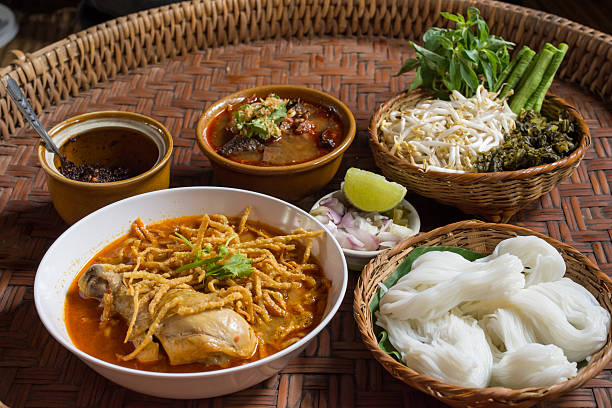
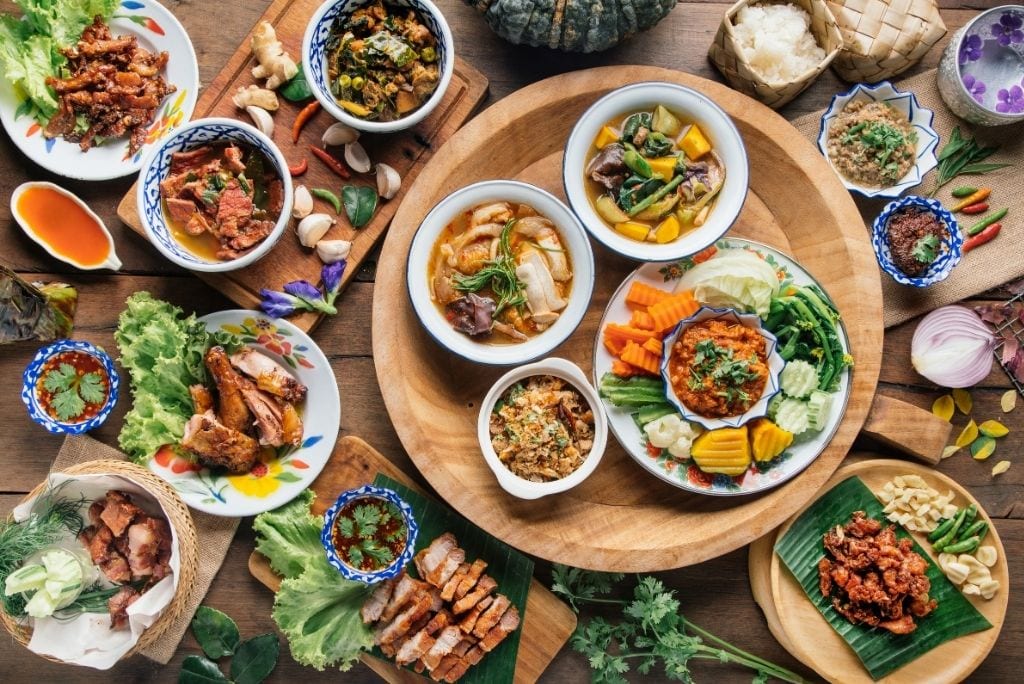
If Bangkok is all about spicy curries and seafood, Northern Thai cuisine is a completely different world. Here in Chiang Mai, food feels slower, heartier, and deeply rooted in tradition. Meals revolve around sticky rice, rolled into small balls and eaten with your hands, paired with a variety of dips, curries, and grilled meats.
The flavors are bold yet balanced. Instead of fiery heat, you’ll often find herbal freshness and smoky depth. Ingredients like galangal, turmeric, kaffir lime, lemongrass, and homemade chili pastes set the tone, giving Northern dishes their distinctive aroma. Many recipes also feature fermented elements from pickled vegetables to preserved fish, which add layers of tanginess and umami.
This unique cuisine is a product of Chiang Mai’s history and geography. Burmese influences brought rich, slow-cooked pork curries; Lao traditions shaped the famous laab (minced meat salad); while Yunnanese settlers introduced comforting noodle soups. All of these culinary threads come together to create a tapestry of flavors you won’t find anywhere else in Thailand.
Dining in the north also has its rhythm. Meals are often shared family-style, with a spread of curries, chili dips, fresh and steamed vegetables, and grilled meats. Sticky rice is the anchor, eaten with your hands to scoop up dips or paired with meat. It’s a communal way of eating that makes every meal feel like a celebration.
Take your taste buds on a vacation and try Northern Thai Cuisine with us, and make it more flavorful and tasteful. We promise your stomach will not be mad at you in this food run.
Chiang Mai Street Food Scene
When the sun sets in Chiang Mai, the city transforms into a bustling kitchen. Markets spill over with sizzling woks, fragrant curries, and endless trays of skewers, dumplings, and sweets. If you are in hunt for legendary dishes or just grazing through the stalls, these night markets are the beating heart of the city’s food culture.
Famous Street Food Markets
1. Chang Phuak Gate (North Gate) Night Market
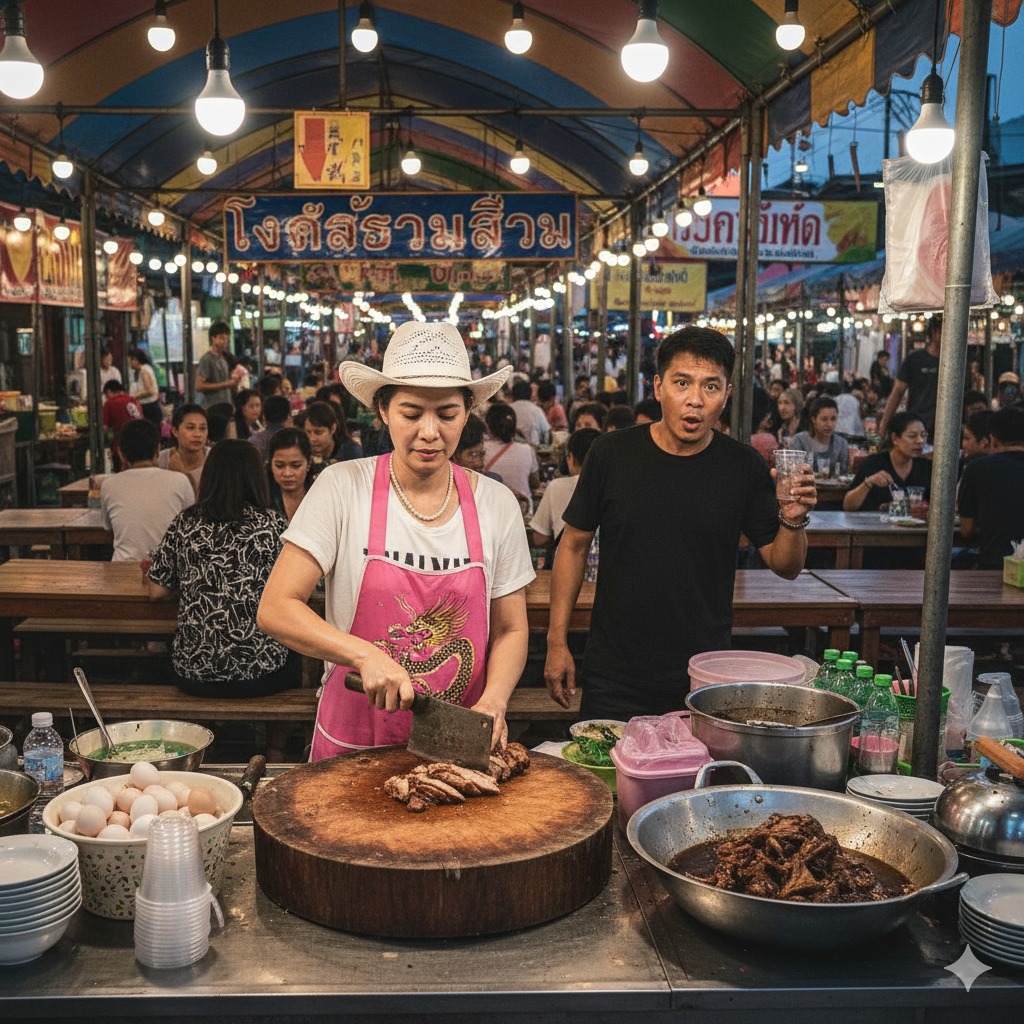
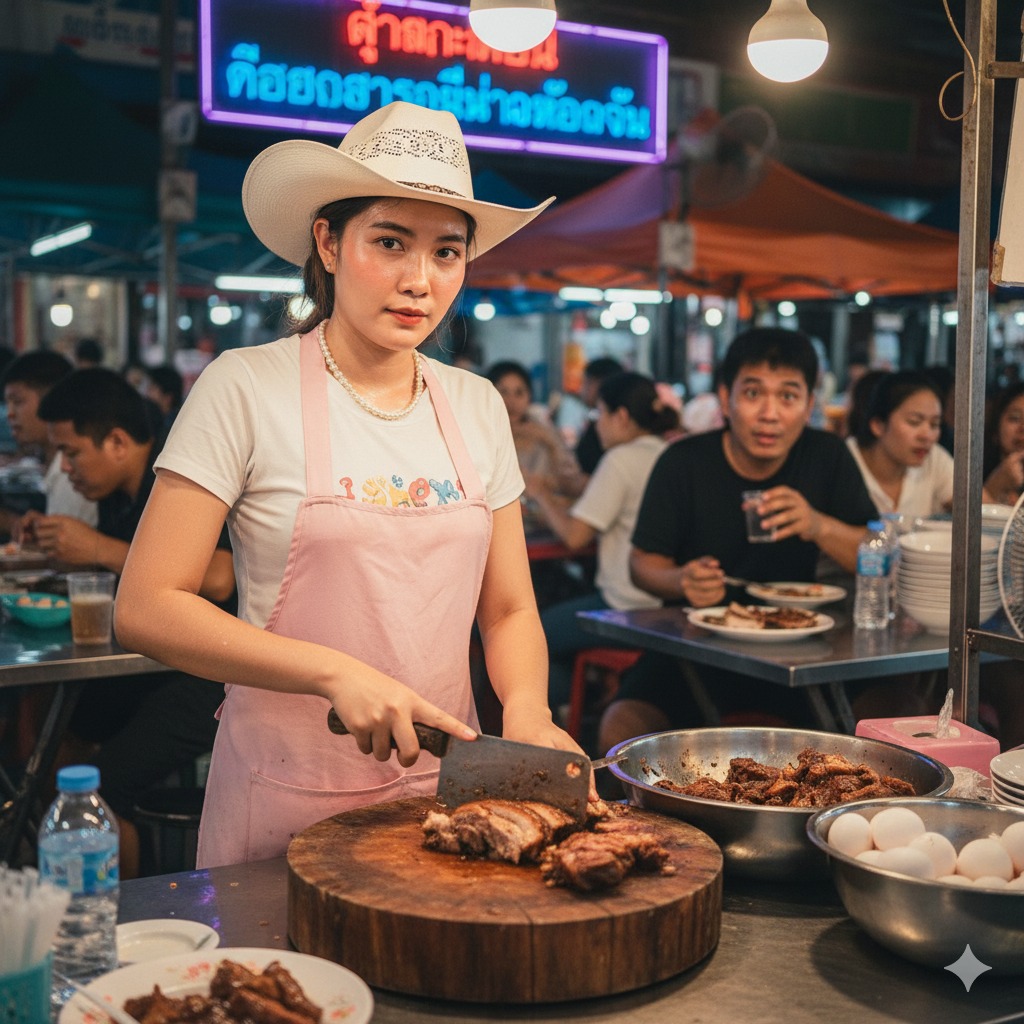
In Chang Phuak Gate Night Market, you’ll find the city’s most iconic street food vendor, the Cowboy Hat Lady, famous for her tender Khao Kha Moo (stewed pork leg over rice). Affordable, hearty, and packed with locals every night, it’s a must-stop for food lovers.
2. Chiang Mai Gate Market (South Gate)
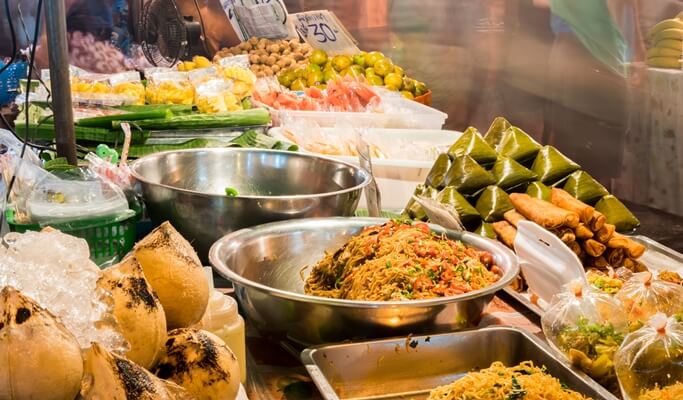
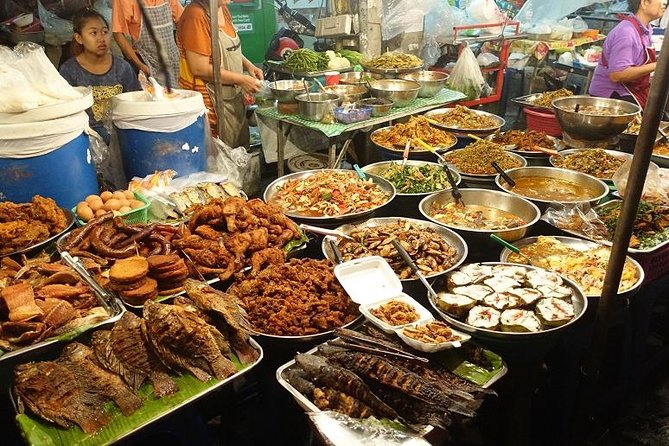
By day, Chiang Mai Gate Market it’s a hub for fresh produce, fruits, and breakfast bites like rice porridge and fried dough sticks. By evening, the gates come alive with street stalls selling everything from grilled chicken to mango sticky rice, perfect for an authentic local dinner.
3. Warorot Market (Kad Luang)
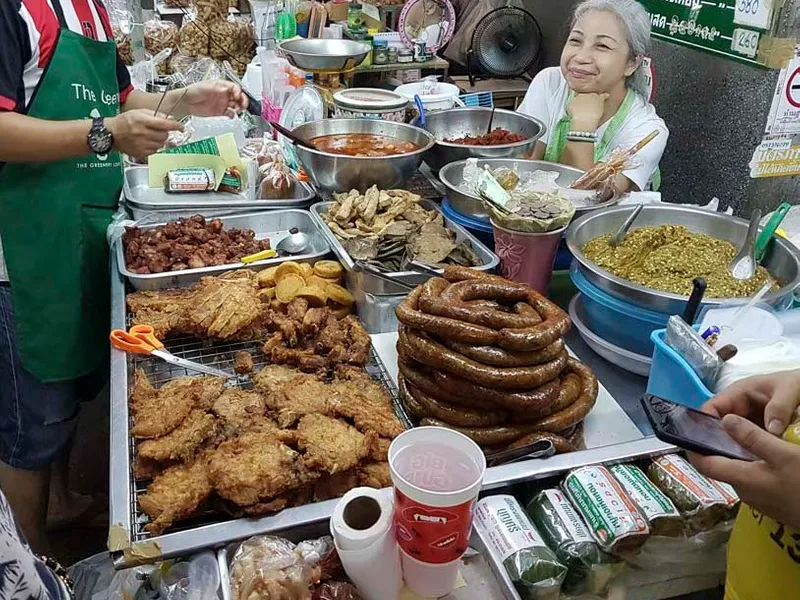
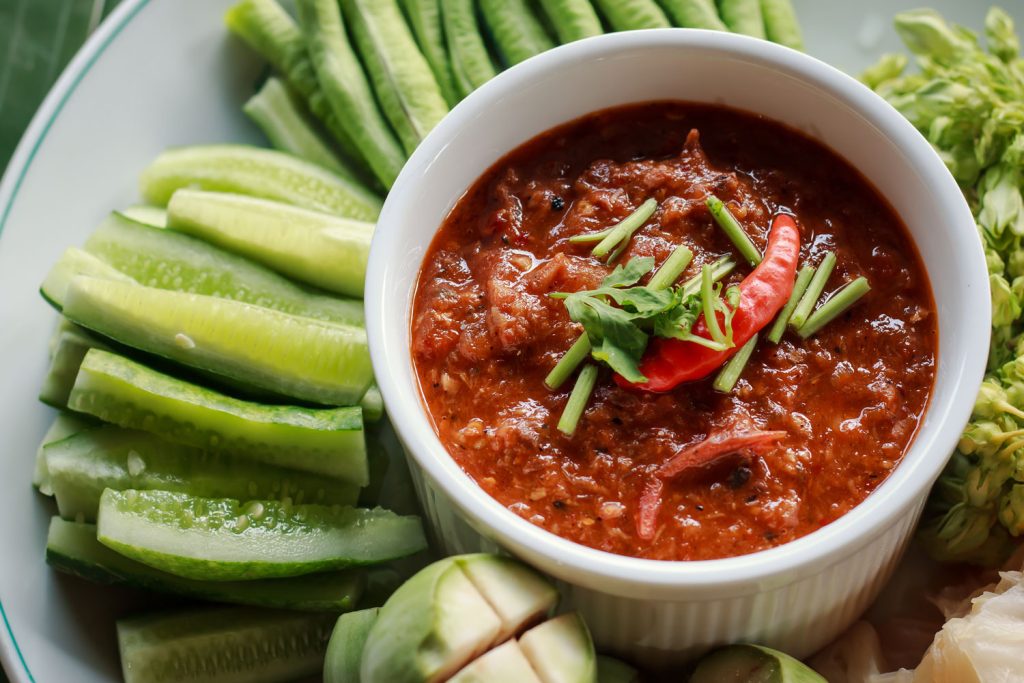
Warorot Market holds the true taste of Northern Thailand. Here you’ll find traditional nam prik (chili dips), sausages, dried herbs, and spices ideal for anyone wanting to explore Chiang Mai’s food culture beyond street snacks. It’s less touristy and more of a local’s market.
4. Sunday Walking Street (Tha Pae Gate)
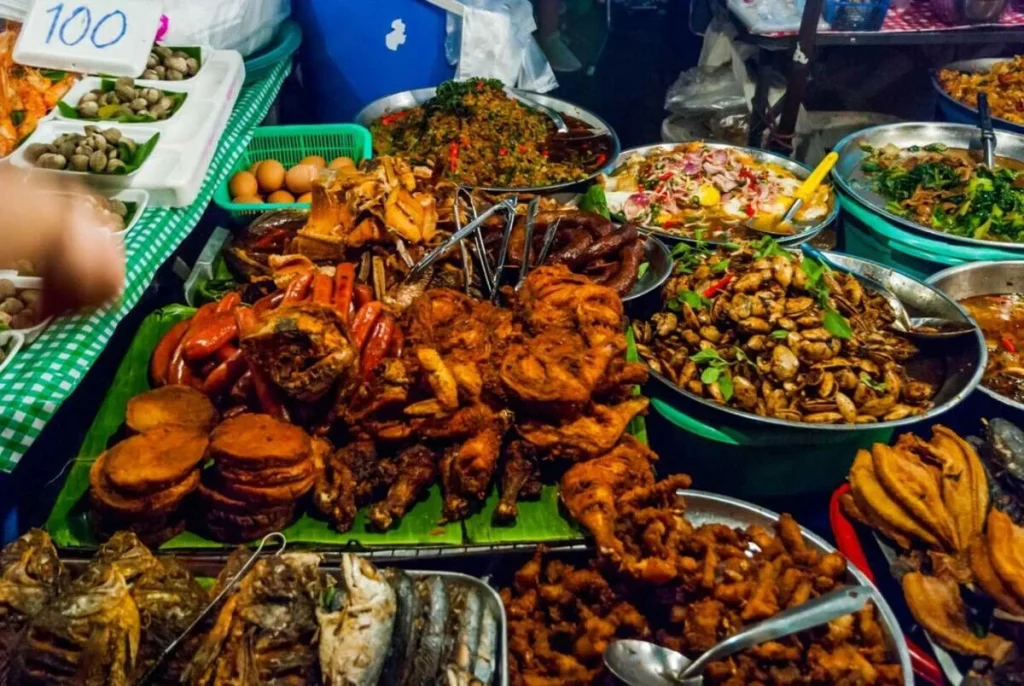
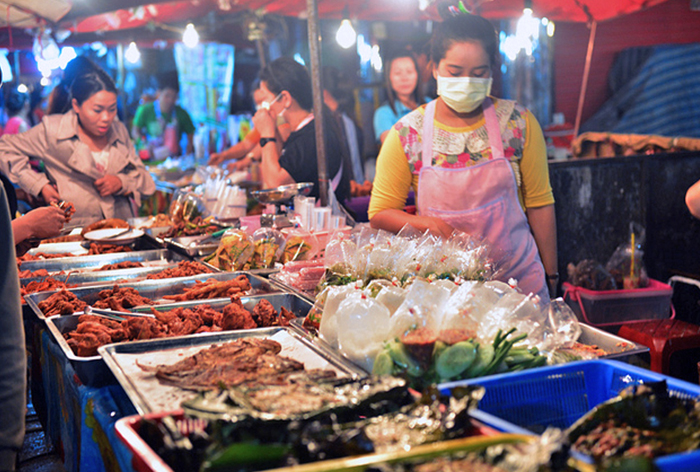
If a foodie’s dream and a cultural feast rolled into one place, then it is Sunday Walking Street. Alongside handicrafts and souvenirs, you’ll find endless rows of street eats, think crispy spring rolls, grilled skewers, coconut ice cream, and sweet pancakes. It’s crowded but worth the stroll.
5. Saturday Wua Lai Walking Street
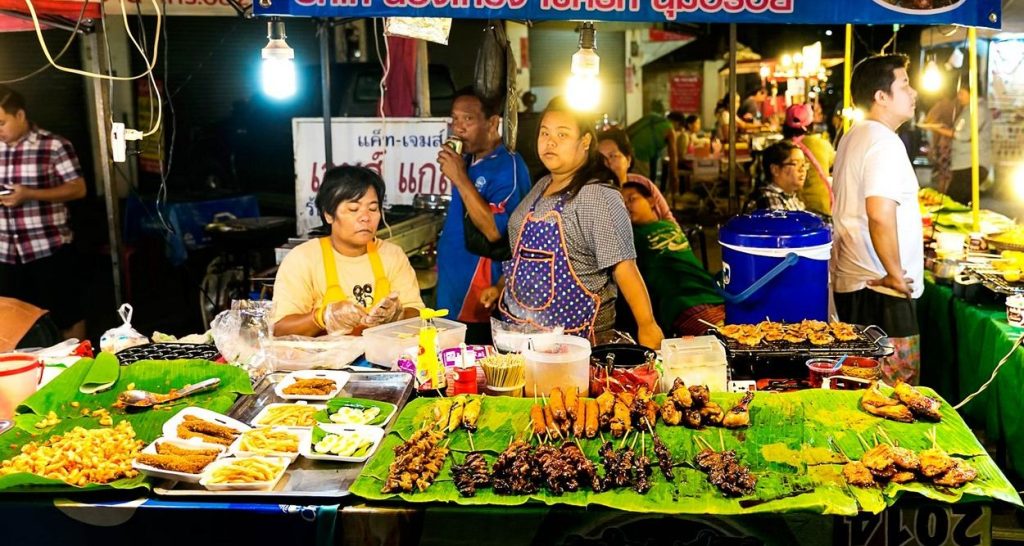
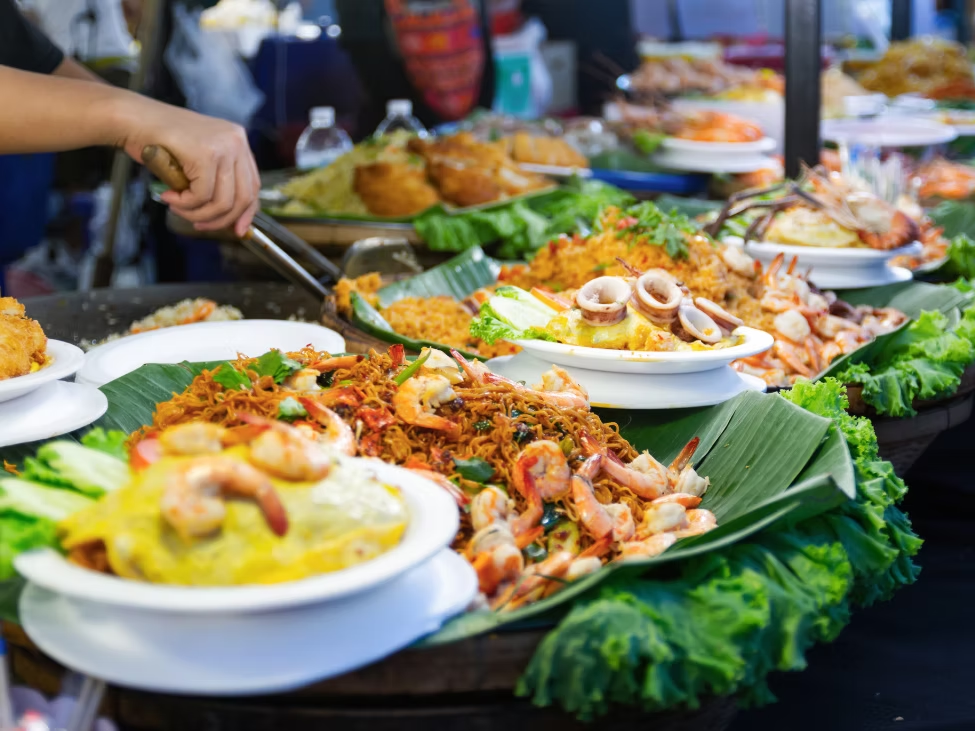
Saturday Wua Lai Walking Street is smaller and less chaotic than Sunday’s version, but just as delicious. The street is lined with stalls serving local snacks, Northern curries, and fresh juices, all while you browse traditional silverware and handmade crafts.
6. Chiang Mai Night Bazaar
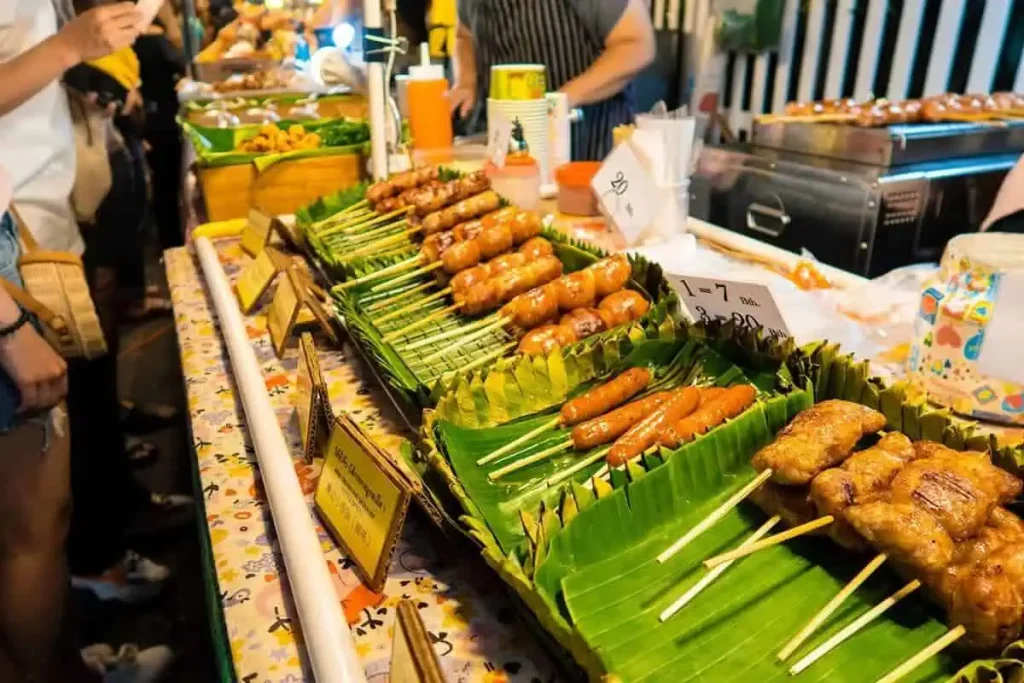
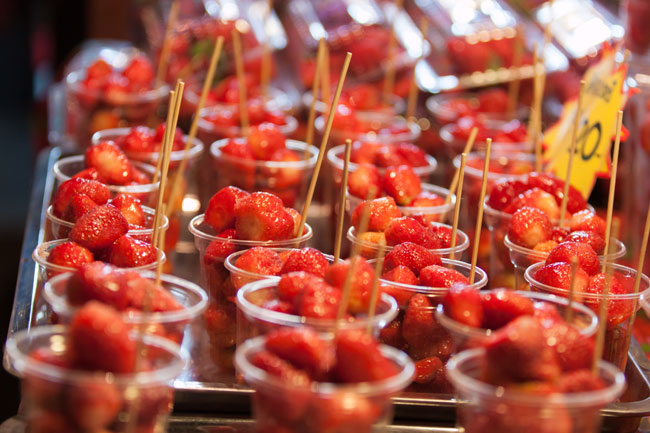
Chiang Mai Night Bazaar is more tourist-oriented, but still great if you want variety under one roof. With dedicated food courts and stalls serving Thai, Chinese, and even Indian dishes, it’s an easy place to sample different flavors in one go.
Must-Try Street Food Dishes
Chiang Mai’s street food isn’t just about filling your stomach; it’s about discovering flavors that tell the story of the north. From rich curries to simple grilled bites, here are the dishes you absolutely shouldn’t miss:
1. Khao Soi
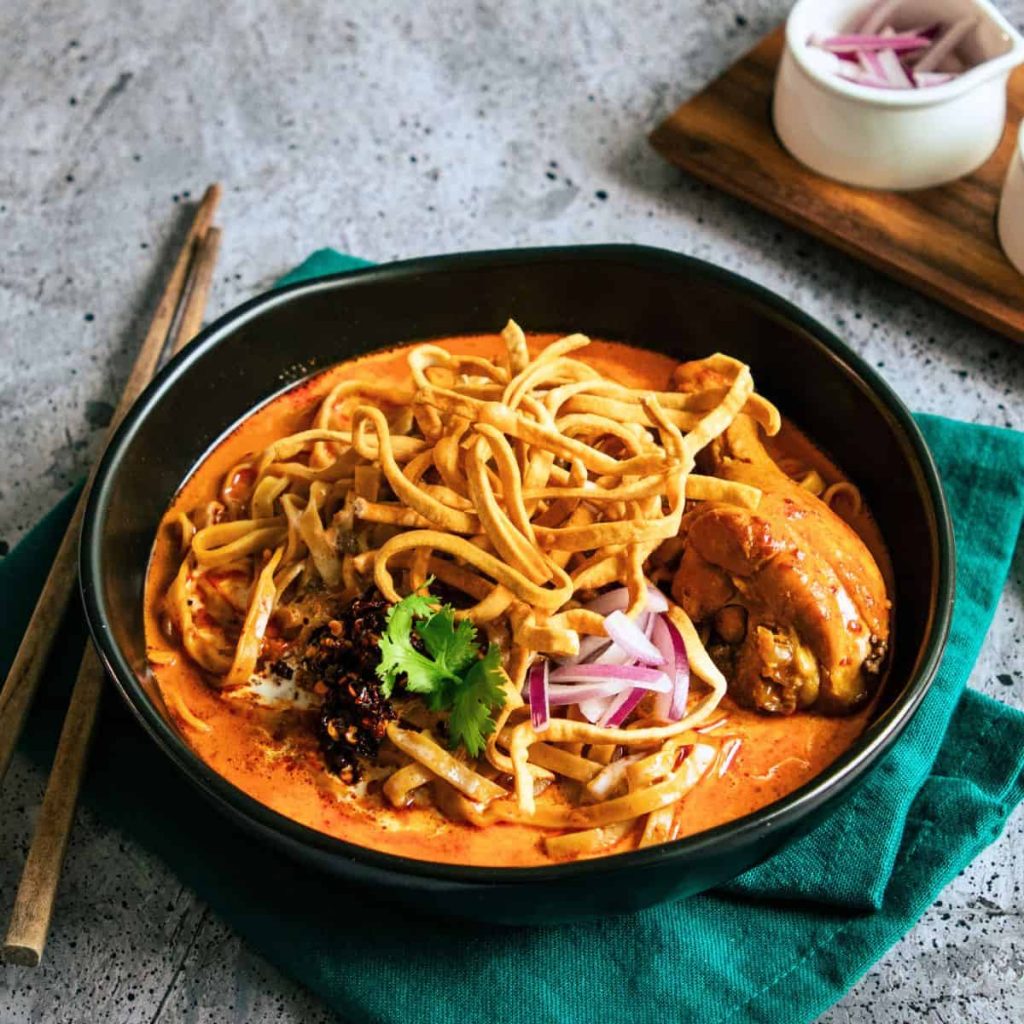
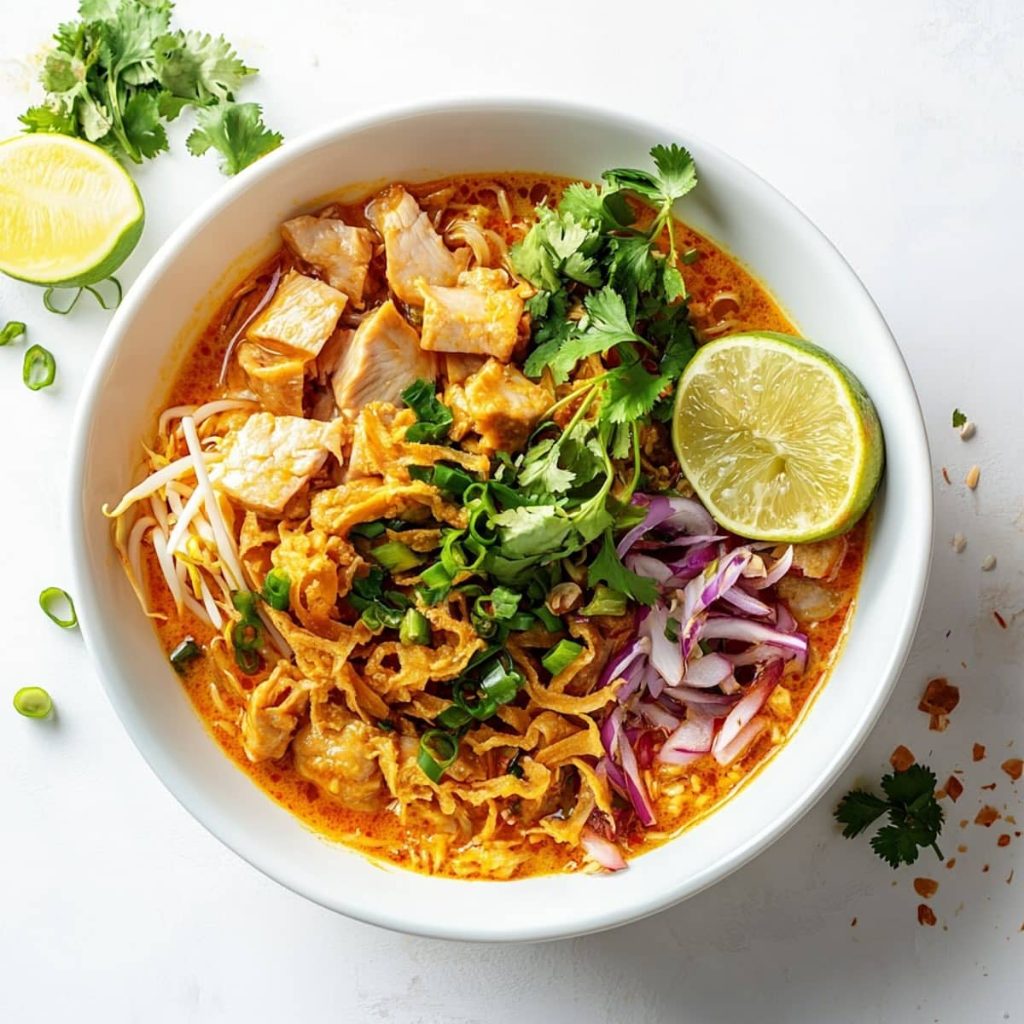
Khao Soi is the crown jewel of Northern Thai cuisine. This coconut curry noodle soup combines silky egg noodles, tender chicken or beef, and a rich, slightly spicy broth, topped with crispy noodles, pickled mustard greens, and lime. Creamy, tangy, and utterly comforting.
2. Sai Oua (Northern Thai Sausage)
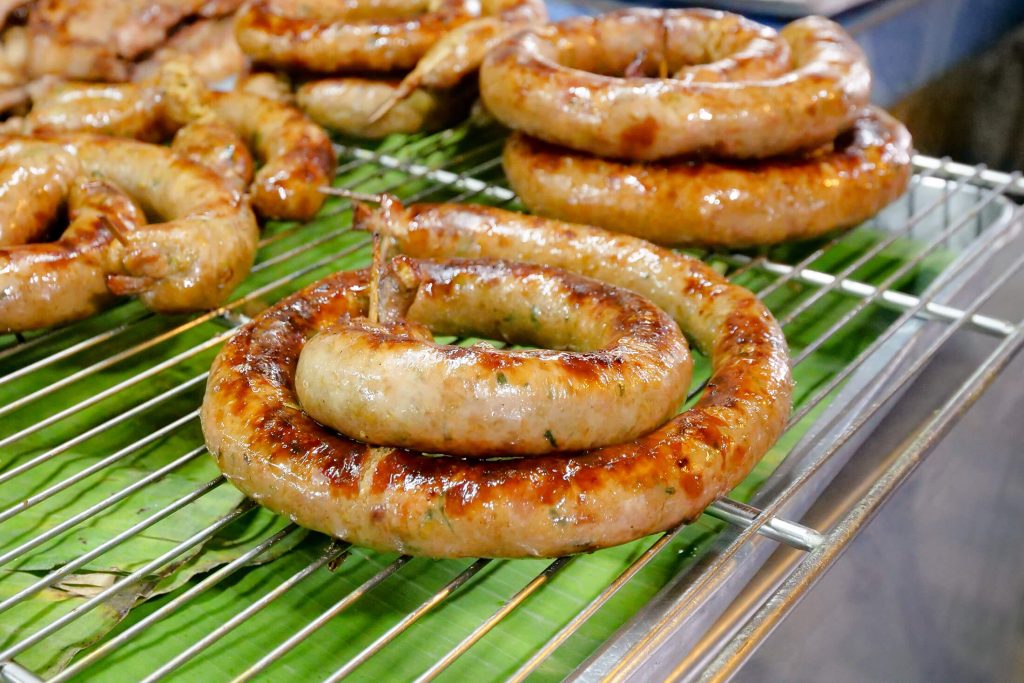
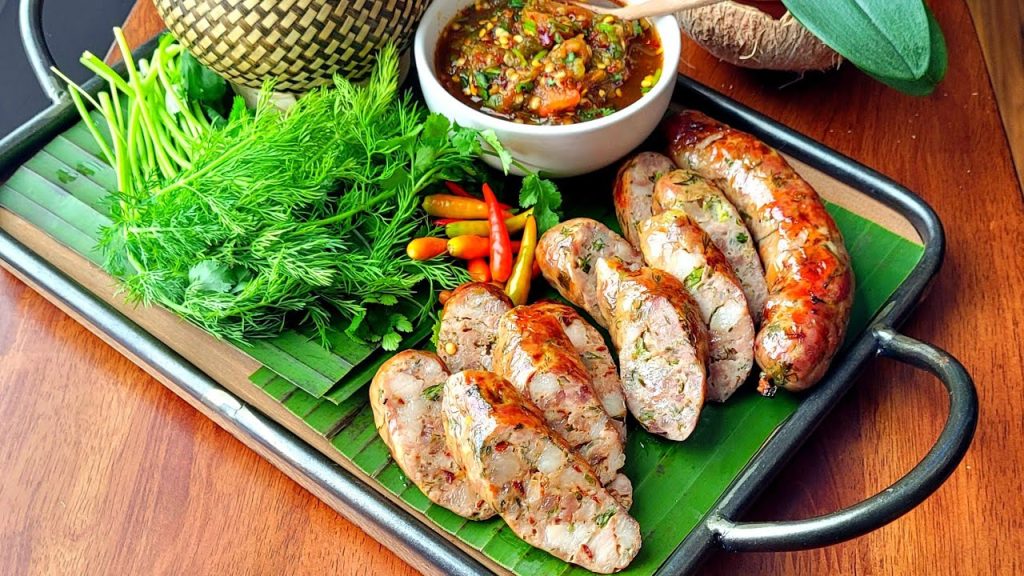
Chiang Mai Street vendors have a street food superstar, then it should be Sai Oua. Packed with herbs, lemongrass, kaffir lime leaves, and chili, this grilled pork sausage bursts with flavor in every bite. Best enjoyed with sticky rice and a spicy dipping sauce.
3. Nam Prik Ong & Nam Prik Noom
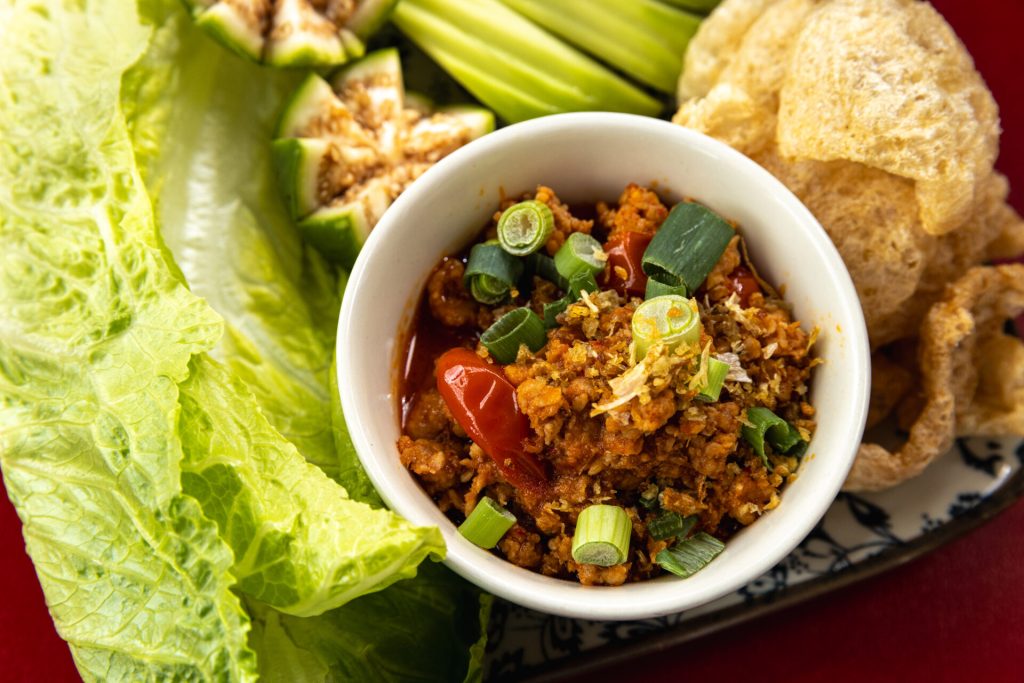
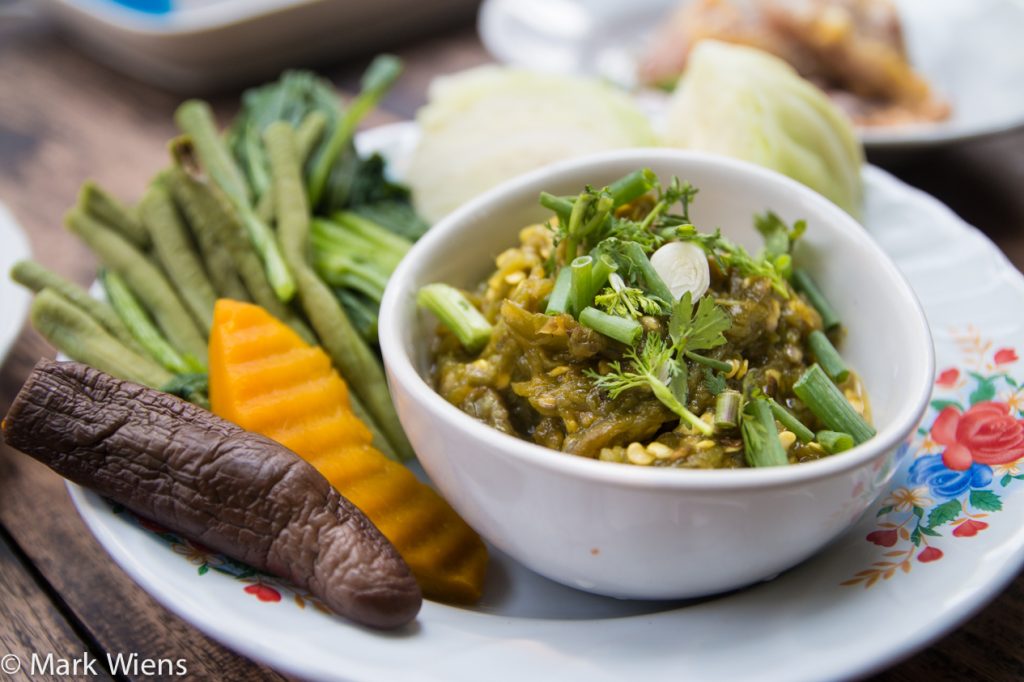
The duo of Chiang Mai chili dips. Nam Prik Ong is tomato-based with minced pork, mild, tangy, and almost like a Thai bolognese. Nam Prik Noom is a smoky green chili dip with a spicy kick. Both are eaten with fresh vegetables or sticky rice.
4. Gaeng Hung Lay
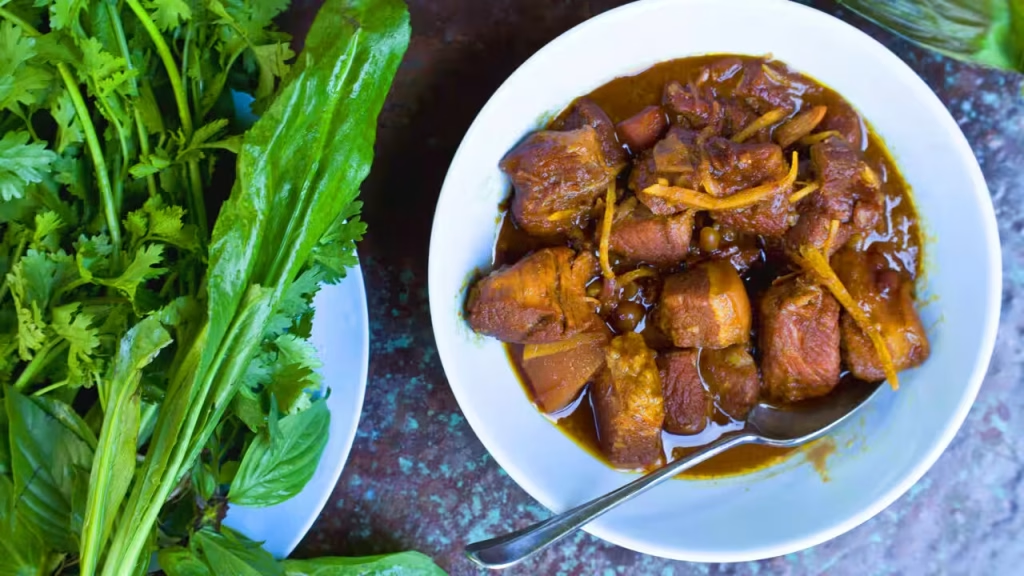
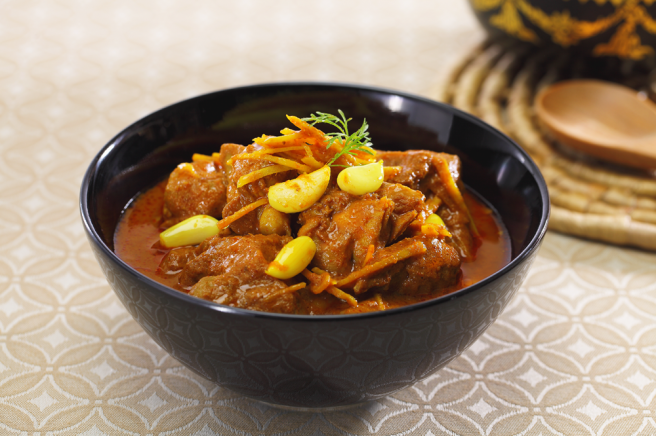
Gaeng Hung Lay is a slow-cooked pork belly curry influenced by Burmese cuisine. Rich with ginger, garlic, and tamarind, it’s less spicy than southern curries but deeply aromatic and sweet-savory in flavor.
5. Grilled Skewers & Meats
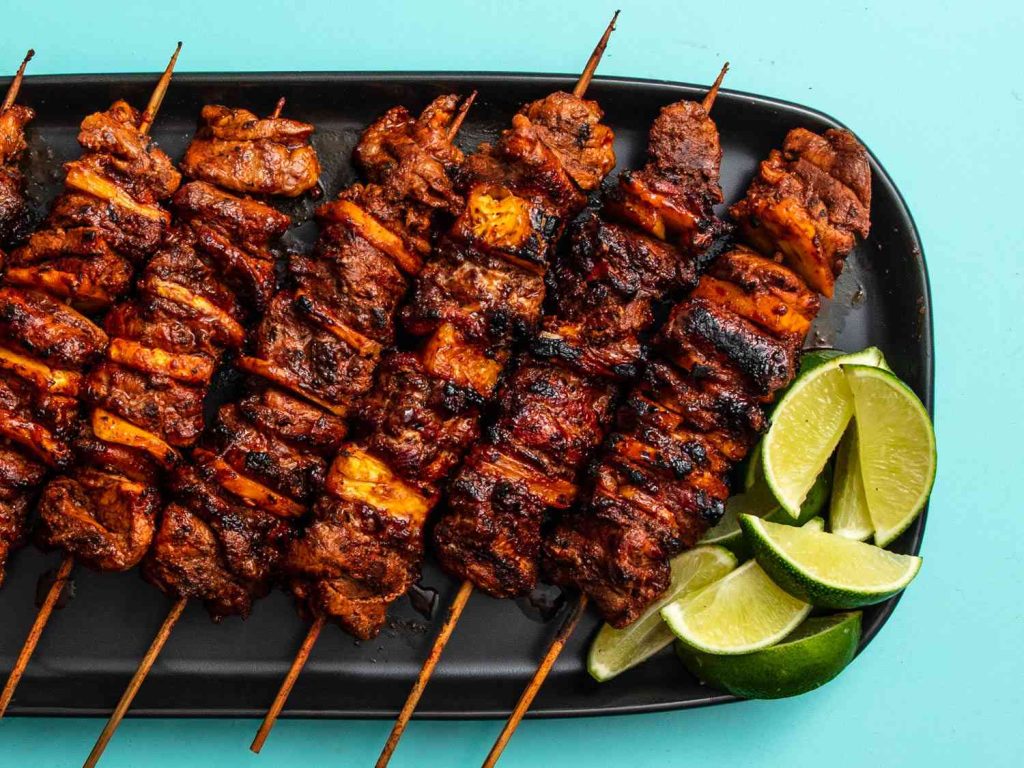
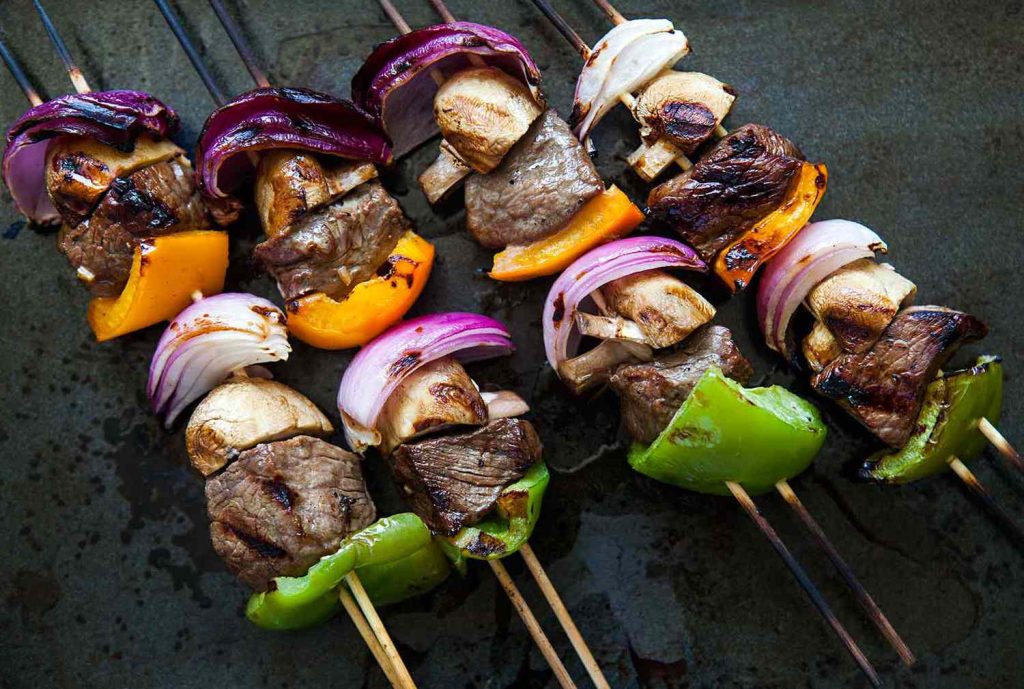
From juicy mooping (grilled pork skewers) to chicken satay with peanut sauce, smoky meats hot off the grill are a street food staple. Affordable, filling, and easy to snack on while wandering the markets.
6. Fried Street Snacks
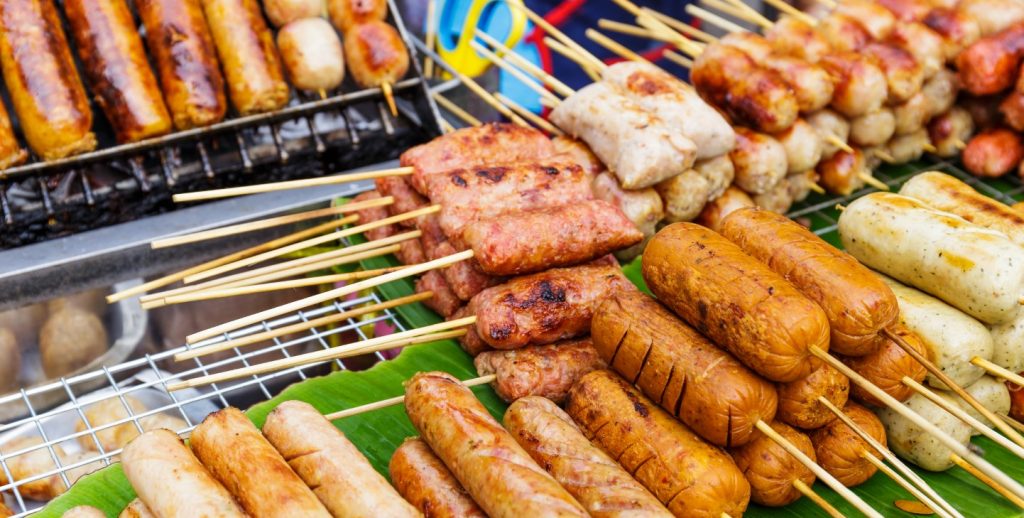
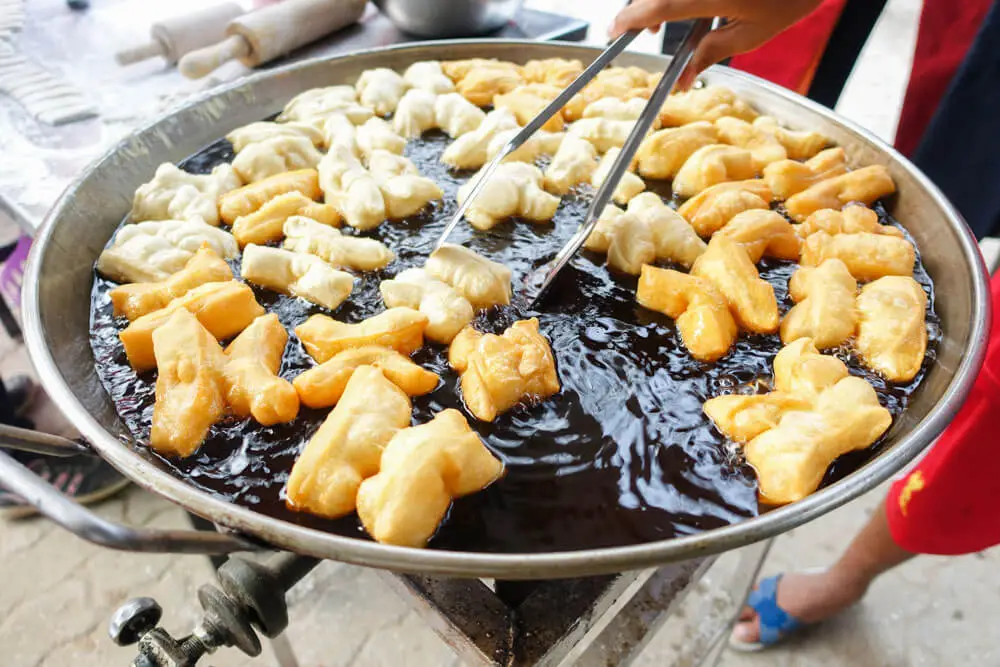
Crispy spring rolls, sweet fried bananas, and chewy roti pancakes (with fillings like banana, Nutella, or condensed milk) are perfect grab-and-go treats for hungry travelers.
7. Sweet Treats
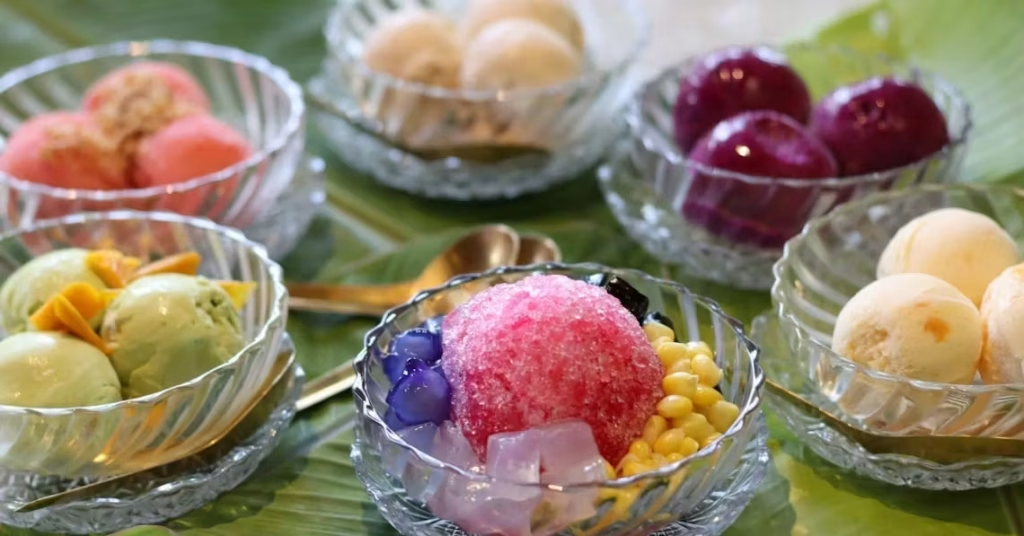
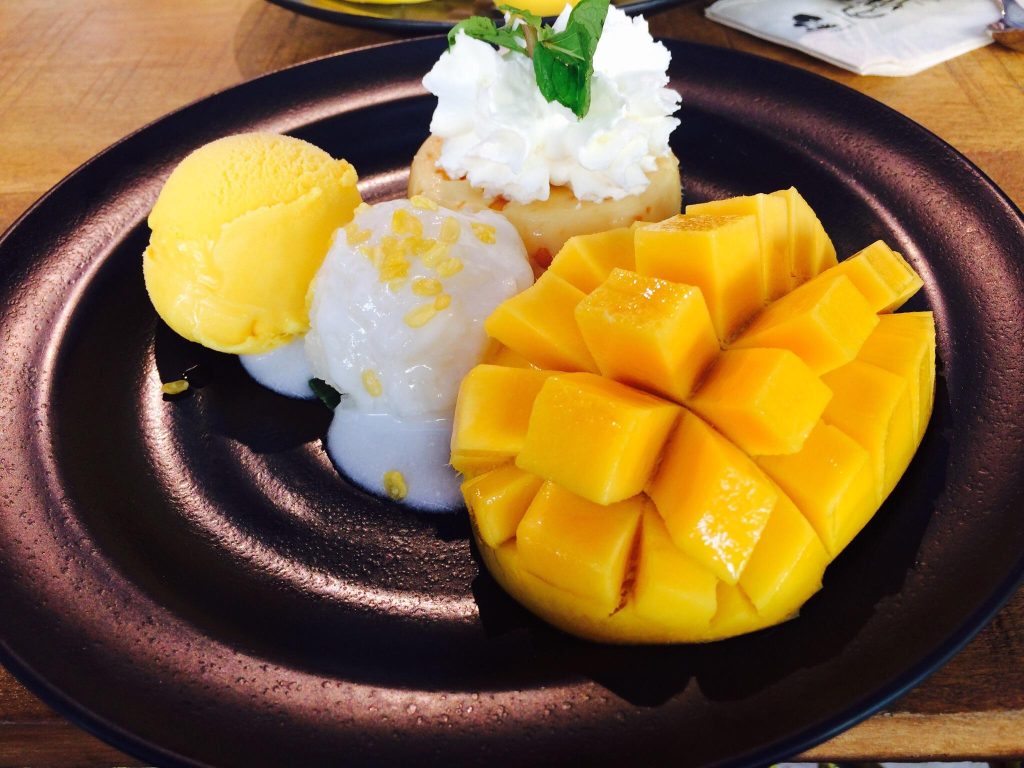
Save room for dessert! Chiang Mai does sweets just as well as savory mango sticky rice, fluffy Thai doughnuts dipped in condensed milk, and refreshing coconut ice cream served in coconut shells are local favorites.
Traditional Northern Thai Dishes Beyond Street Food
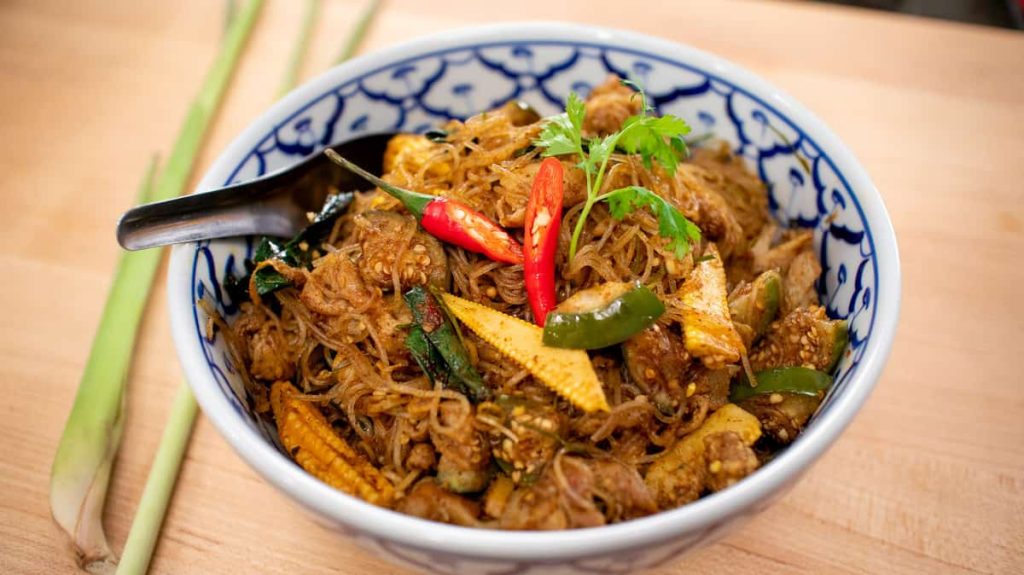
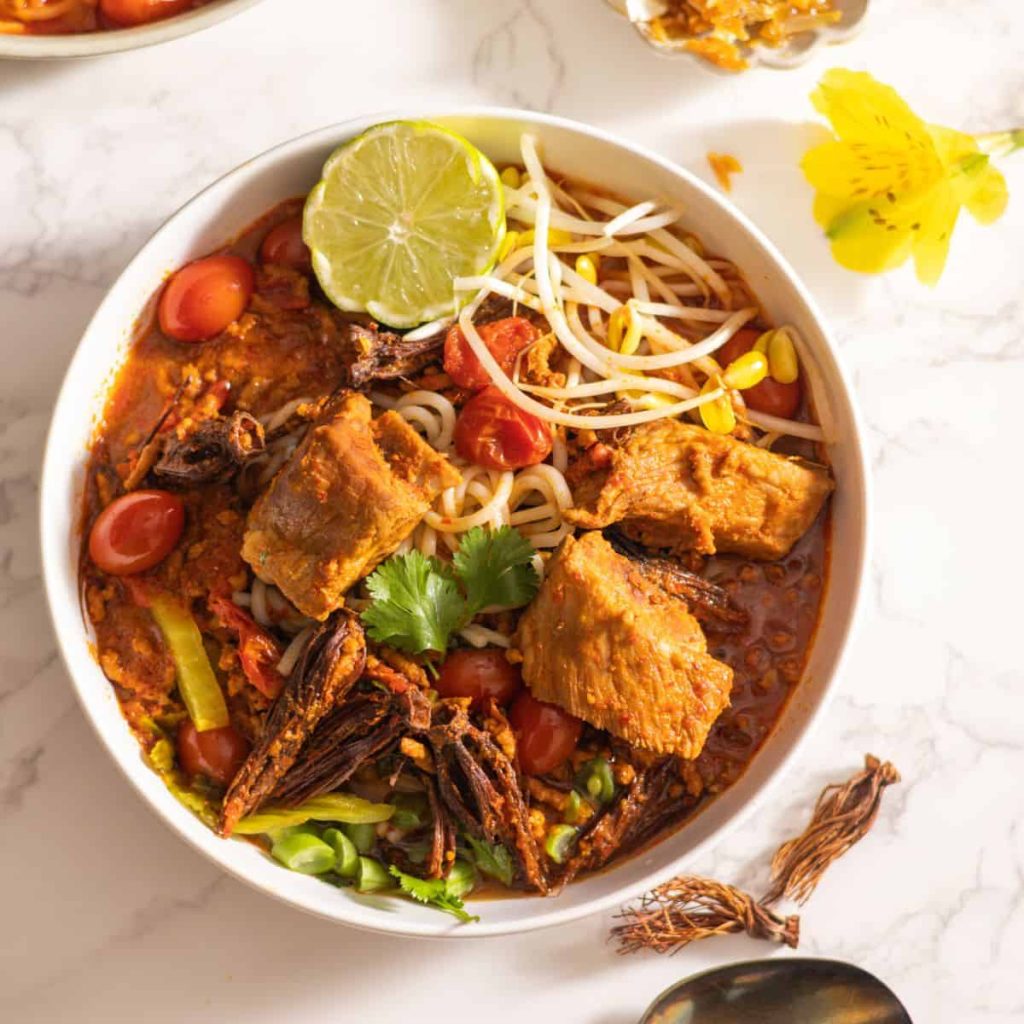
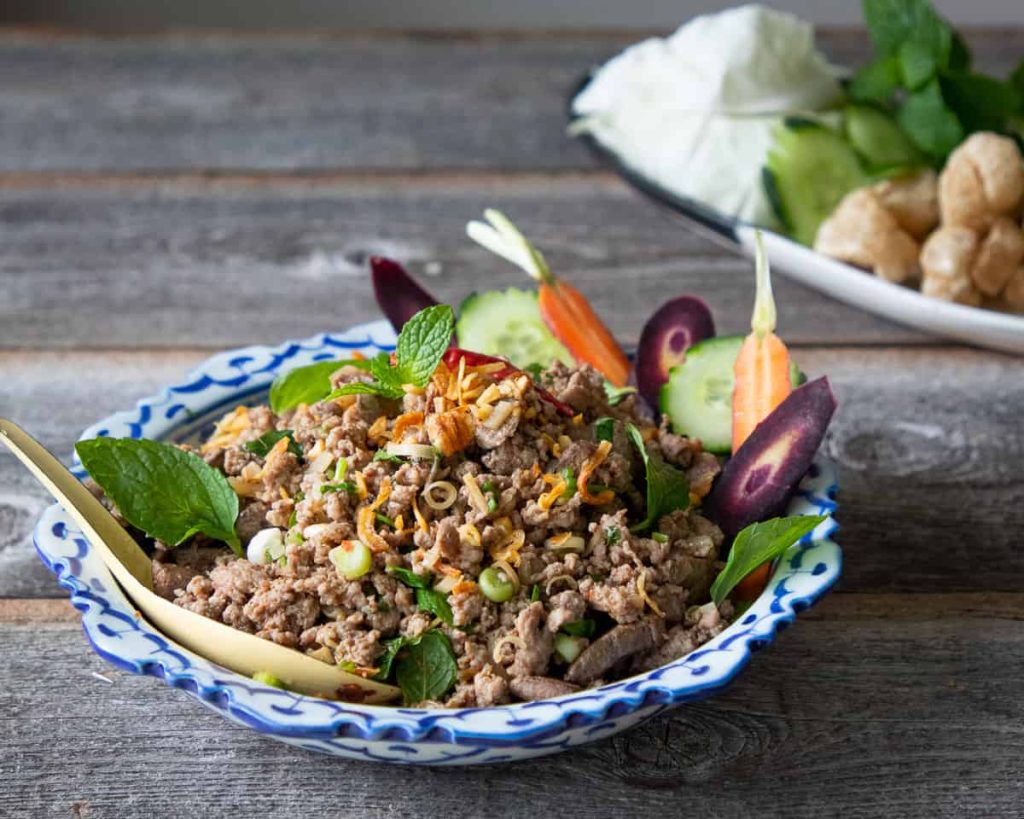
| Dish | What It Is | Cultural Context |
| Laab Kua | Northern-style minced meat salad, herby, spicy, often richer than the Isaan version | Often served at family gatherings, festive meals, and special occasions |
| Nam Ngiao | Shan-style tomato noodle soup with minced pork, dried flowers, and pork blood curd | A comforting community dish, commonly found in temple fairs and local feasts |
| Gaeng Hoh | Stir-fried curry made with leftover meats, glass noodles, and curry paste | Traditionally, a no-waste dish, prepared after big ceremonies or communal events |
| Kaeng Khanun | Curry made with young jackfruit, tomatoes, and herbs | Popular during the Buddhist Lent, when meals are more vegetable-focused |
| Tam Khanun | Young jackfruit salad, spicy and tangy | Served at merit-making ceremonies and temple offerings |
| Fermented Favorites | Includes pickled mustard greens and pla som (fermented fish) | Rooted in preservation traditions, often part of family meals, and long-term storage of food |
Chiang Mai’s Cafe & Coffee Culture
Chiang Mai isn’t just famous for temples and night markets; it’s also Thailand’s coffee capital. With beans grown in the surrounding mountains and a thriving cafe scene, the city is a dream come true for coffee lovers. Whether you’re a digital nomad, an Instagrammer, or a true coffee connoisseur, Chiang Mai has a cafe that feels made for you.
- Mountain-Grown Beans
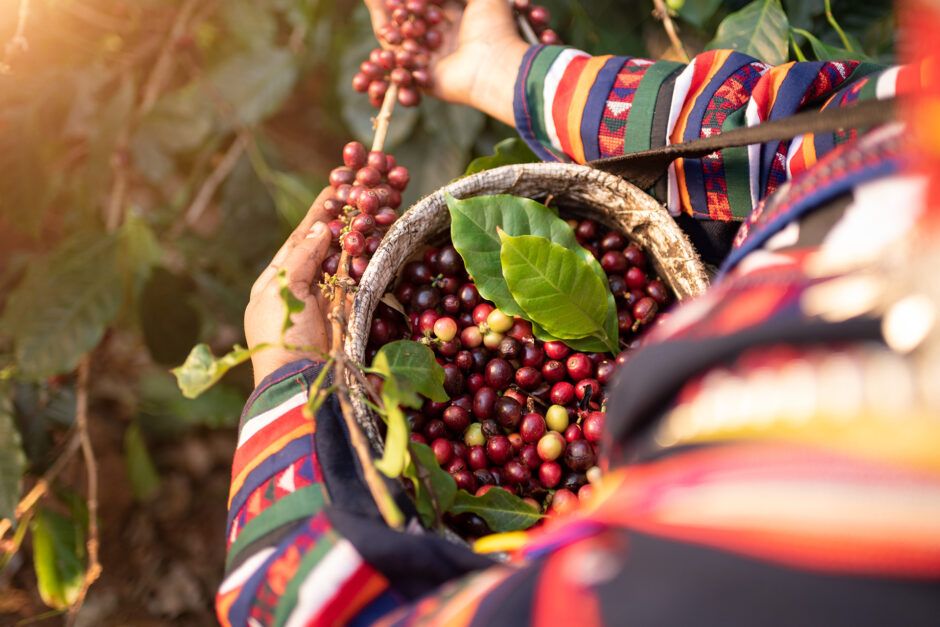
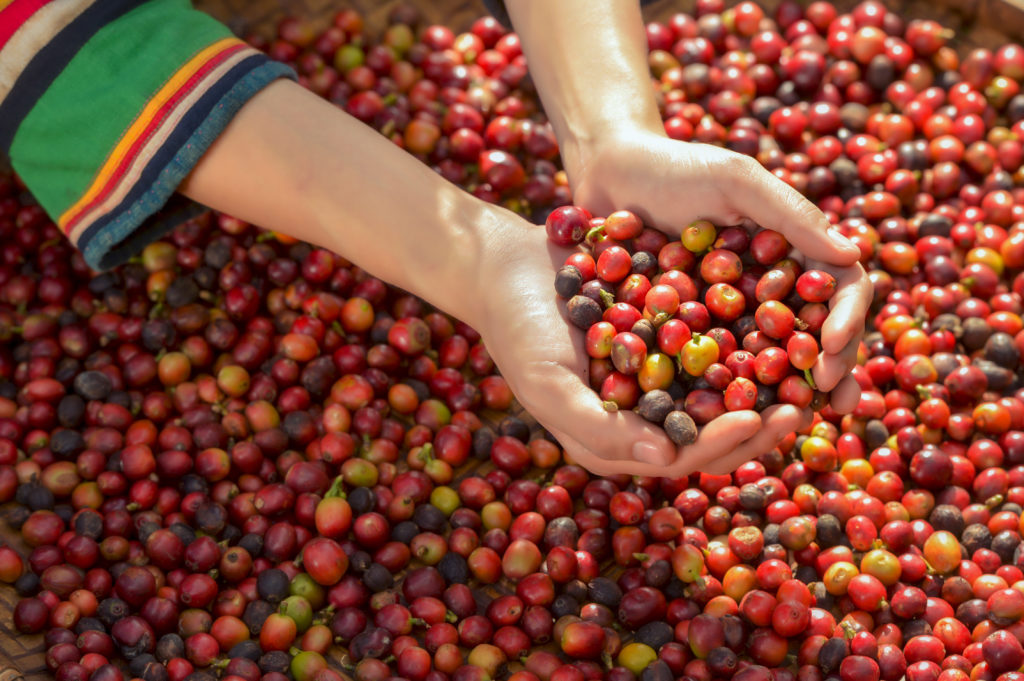
Coffee cultivation thrives on the cool, misty slopes of Doi Suthep, Doi Saket, and Doi Inthanon. The rich soil and high altitude produce beans with complex flavors that rival those from Latin America or Africa.
- Hill-Tribe Farmers & Sustainability
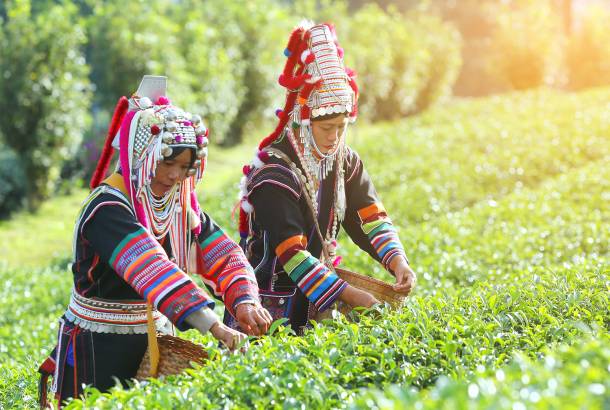
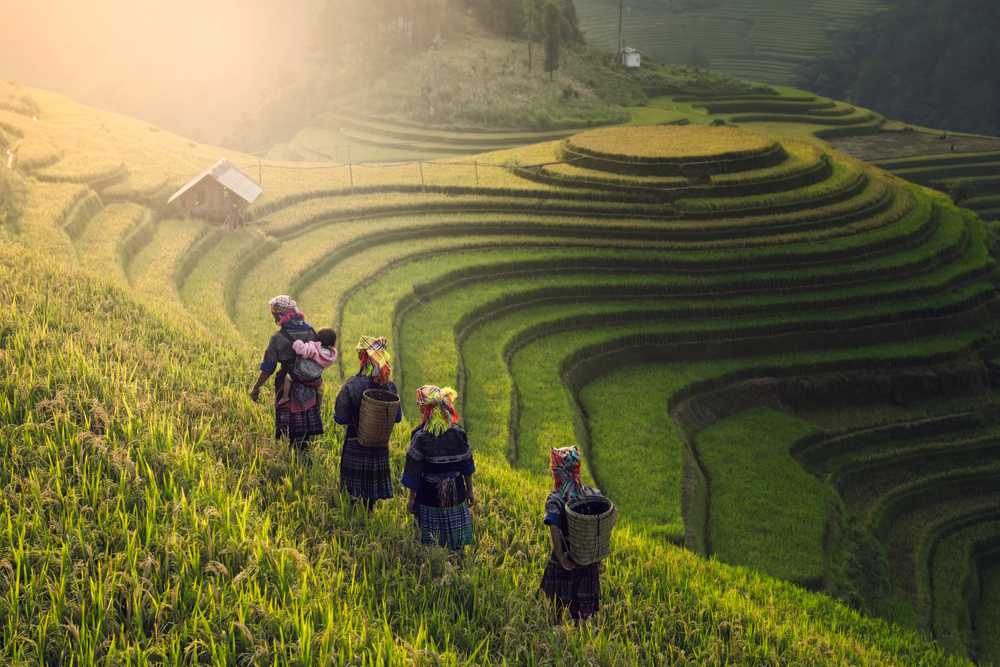
Many of Chiang Mai’s finest beans are cultivated by Akha and other hill-tribe farmers, who practice sustainable, small-batch farming. Supporting local cafes often means directly helping the local community.
- Third-Wave Coffee Movement

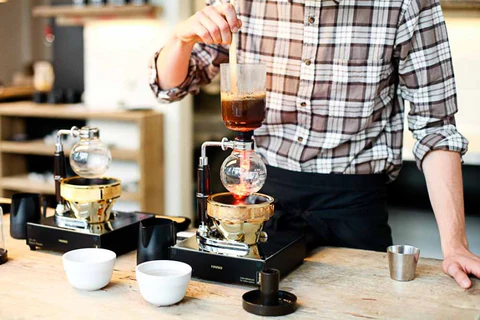
Over the past decade, Chiang Mai has embraced third-wave specialty coffee, with baristas experimenting with pour-over, cold brew, and single-origin espresso. Cafes here are as much about craftsmanship as caffeine.
Best Cafes and Foodie Experiences in Chiang Mai
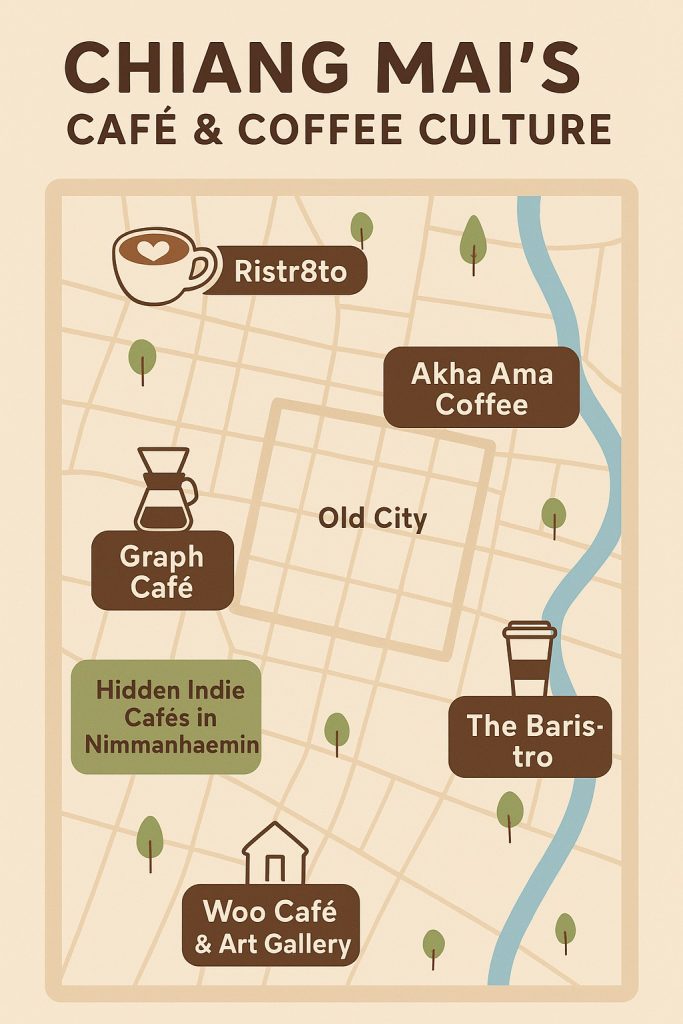
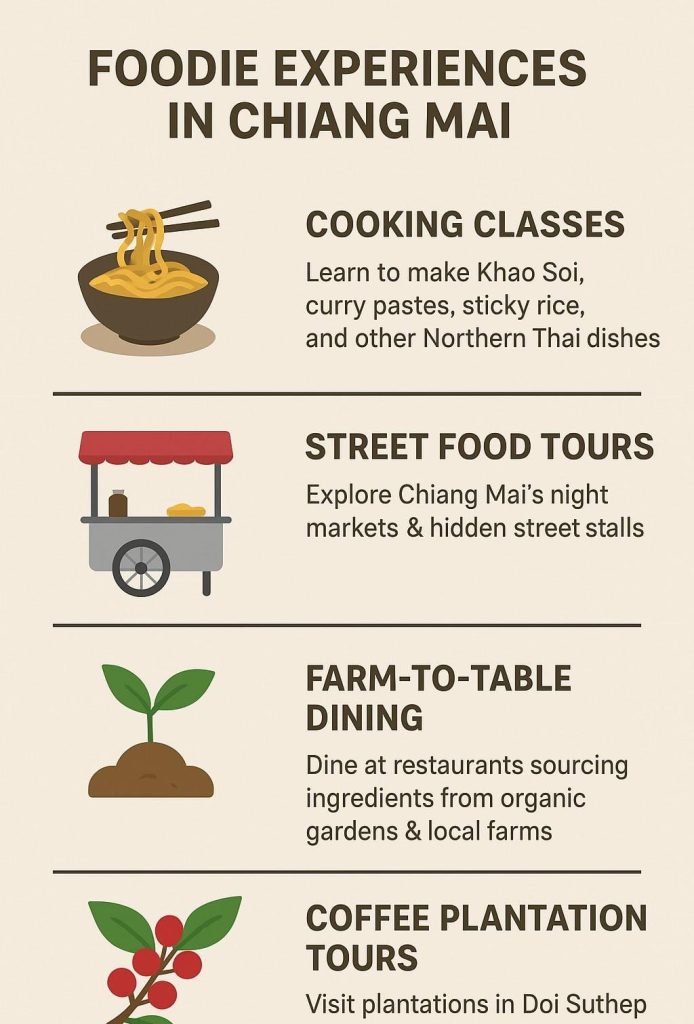
Michelin Guide & Local Dining Gems in Chiang Mai
Chiang Mai has earned its place on the global culinary map, not just through its vibrant street food but also by being featured in the Michelin Guide. Several stalls and humble eateries have received the Bib Gourmand distinction, which highlights affordable yet high-quality dining. Among the most famous are Khao Soi Mae Sai and Khao Soi Islam, both legendary spots where locals and visitors line up for a bowl of rich, curry-laden noodles.
Beyond street eats, the city is home to upscale modern dining experiences that reimagine Northern Thai flavors. Restaurants like Blackitch Artisan Kitchen and Ginger Farm Kitchen are pioneers of this movement, serving seasonal dishes with farm-to-table freshness and artistic flair. These places offer a creative twist while staying rooted in local ingredients and traditions.
Yet, some of Chiang Mai’s true treasures remain the family-run eateries tucked away in small neighborhoods. These mom-and-pop curry houses and noodle shops are where you’ll find recipes passed down through generations, hearty portions, and the kind of warm hospitality that makes you feel like part of the family. For many food lovers, these hidden gems offer the most authentic taste of Chiang Mai’s culinary soul.
Hidden Family-Run Treasures
Khao Soi Mae Manee
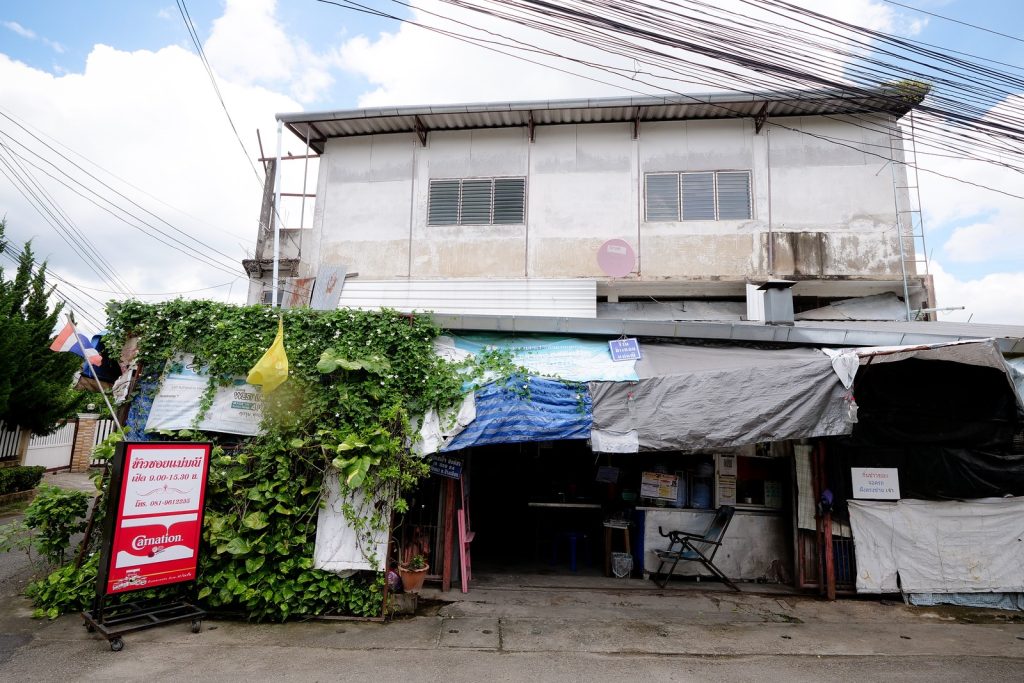
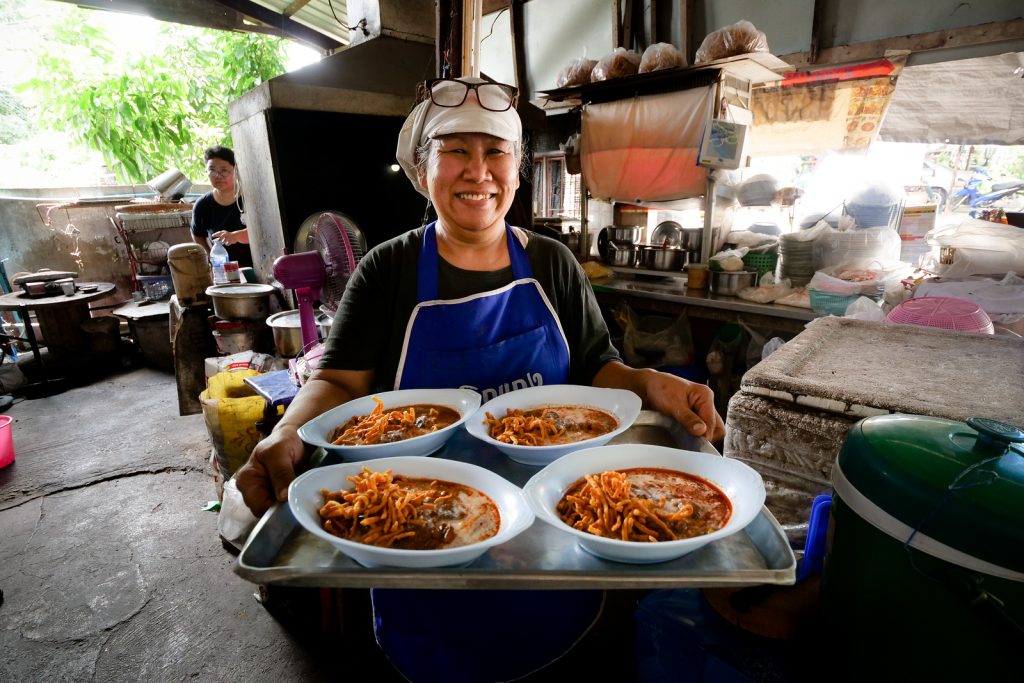
A humble, family-run noodle shop located just north of the Old City, this spot has been serving rich, intensely flavored khao soi for over 50 years. Expect a thick, aromatic curry broth and a warm welcome from the same family who’s been cooking it all these decades.
Han Teung Chiang Ma
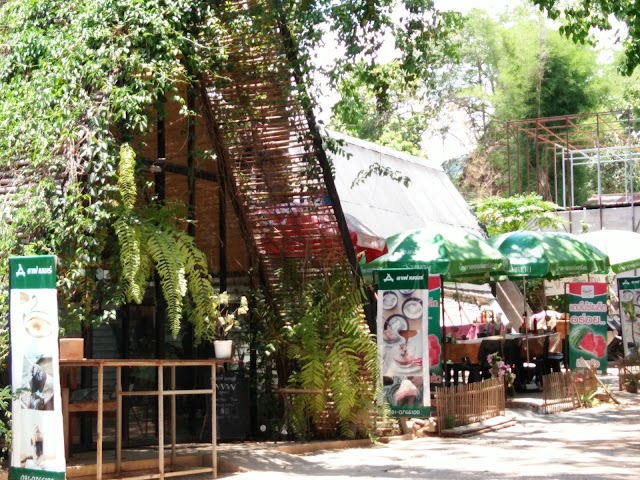
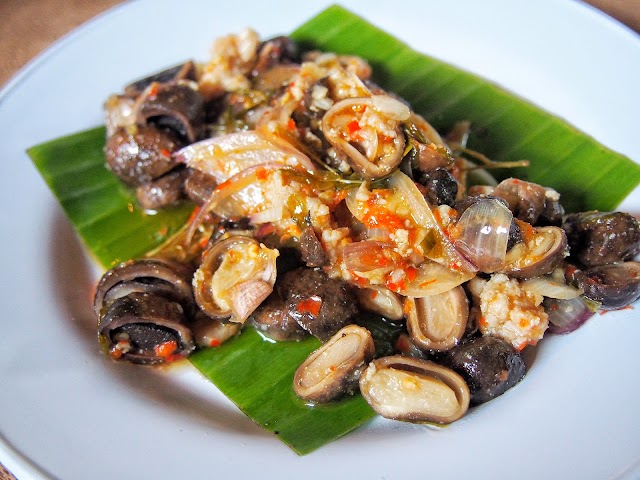
Han Teung Chiang Ma, rarely visited by tourists, this no-frills eatery remains beloved by locals from across Thailand. It’s where flavor, not flash, takes center stage.
Puang Thong

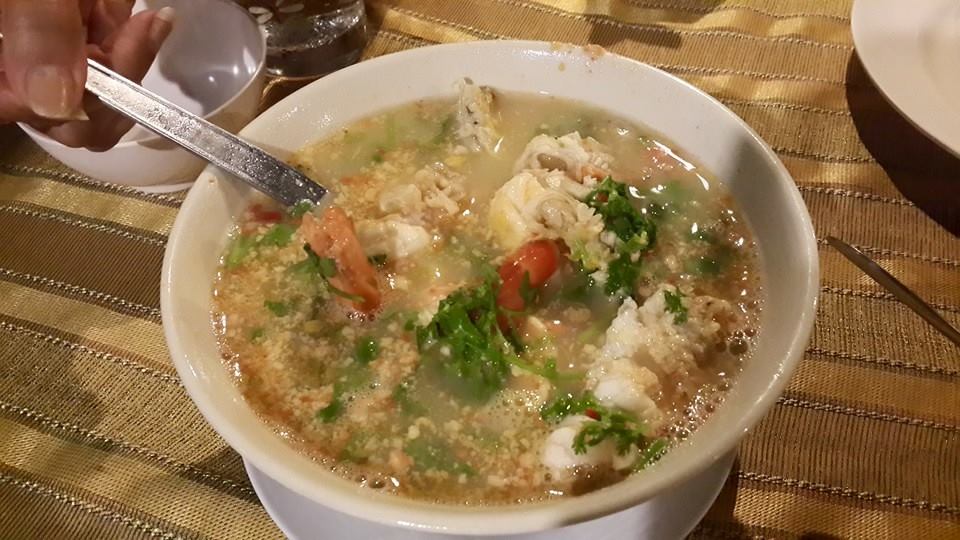
Nestled by the riverfront near the ancient city gate, Puang Thong serves up hearty dishes like river prawns, squid salad, and spicy hot-and-sour soups. A quiet gem for food lovers in the know.
Nua Satay Tai Ton Khoi
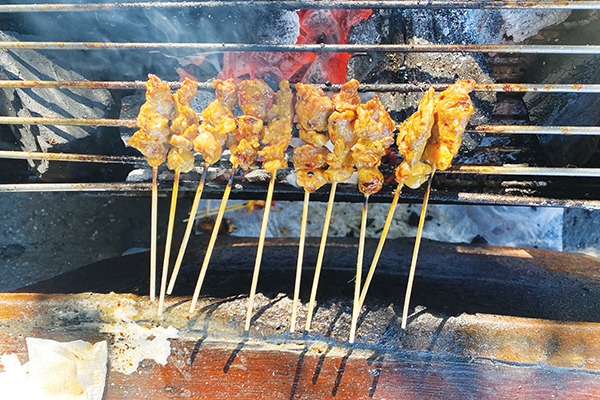
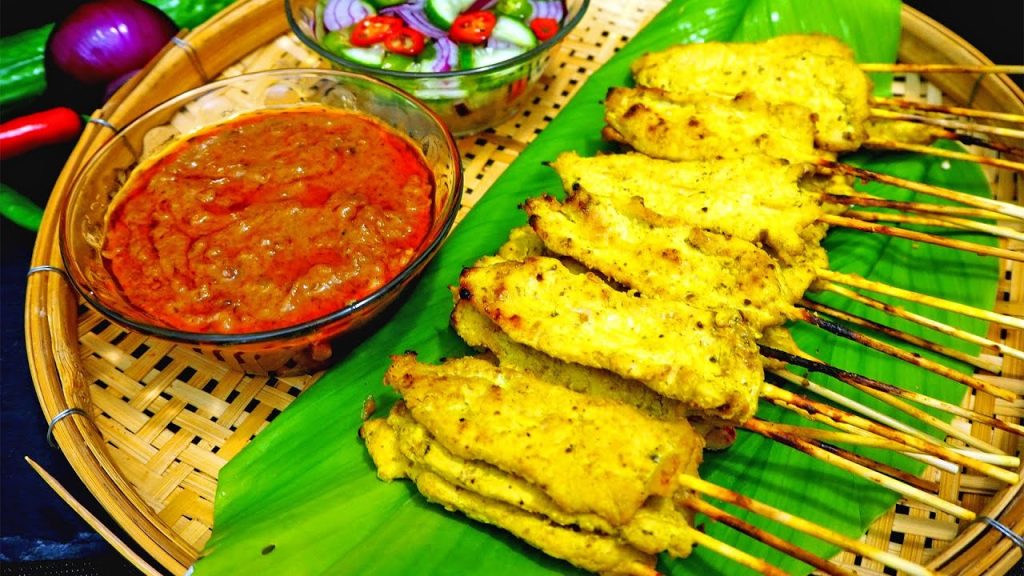
For a street-side, spontaneous experience, this mobile satay stand is unforgettable. A lady wheels out a barbecue onto a low table, then keeps serving until you say stop. Just make sure you’re ready to indulge and order extra!
Vegetarian, Vegan & Dietary-Friendly Eats in Chiang Mai
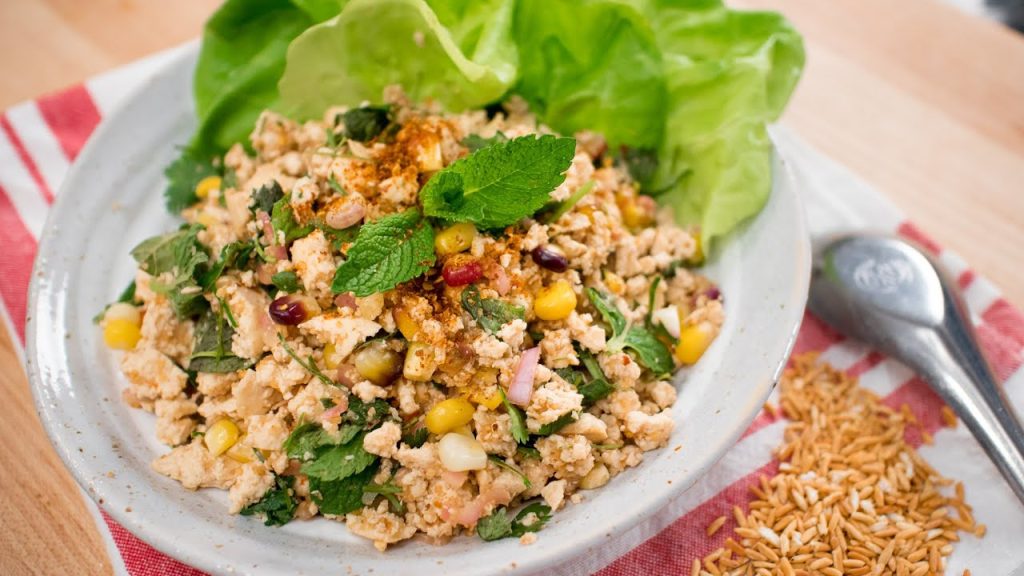
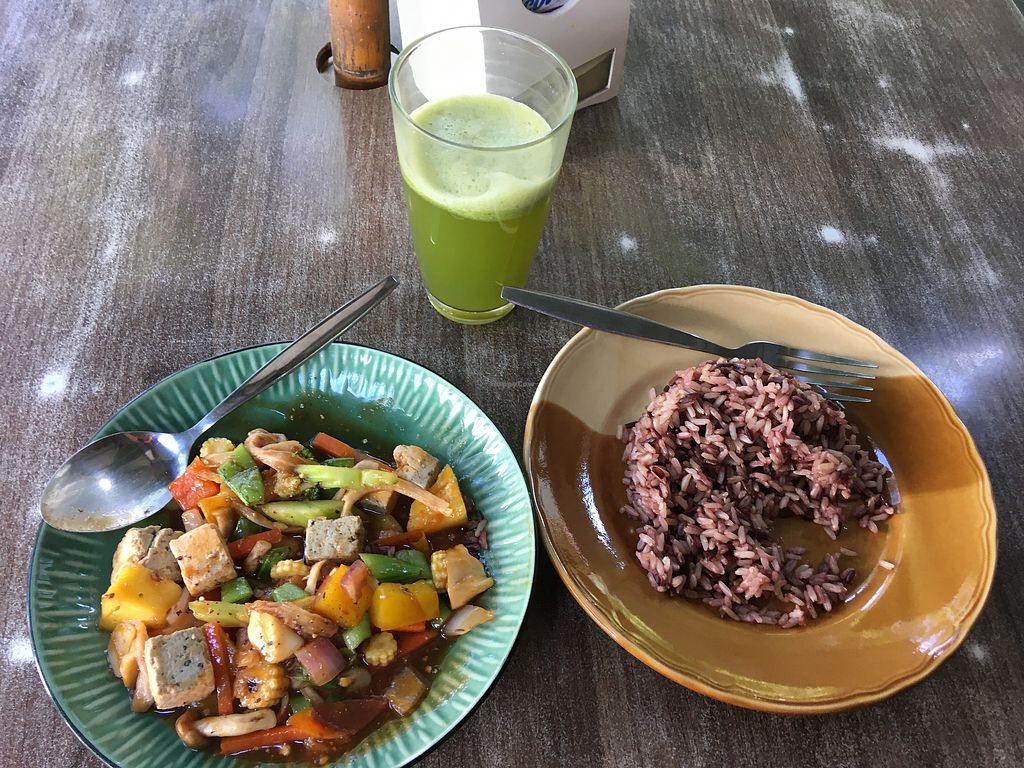
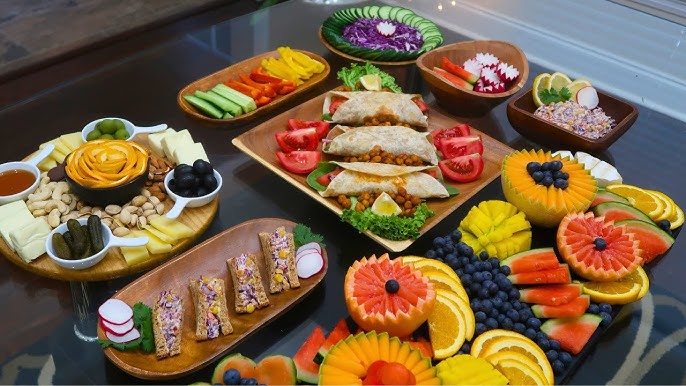
| Category | Examples / Adaptations | Where to Try |
| Adapting Northern Thai Dishes | Vegan Khao Soi (coconut milk base, crispy noodles, tofu/mushroom protein), Tofu Laab (spicy herb salad with tofu instead of meat), Mushroom curries (earthy, rich in Lanna spices) | Many local veggie-friendly restaurants & cafés (Old Town & Nimmanhaemin) |
| Best Vegan/Vegetarian Restaurants & Cafés | Pun Pun Organic (community-driven, sustainable, Thai veggie dishes) – Anchan Vegetarian (colorful curries & vegan Thai classics) – Goodsouls Kitchen (Western–Thai fusion, fully vegan) – Amrita Garden (Japanese-inspired, macrobiotic options) | Old City, Santitham, Nimmanhaemin |
| Smoothie Bars & Health-Conscious Options | Cold-pressed juices, smoothie bowls, superfood shakes, plant-based breakfast sets | Fruit Pulse Cafe – Accha Smoothie Cafe – Vegan Heaven Smoothies – Nimman & Old Town juice bars |
Food & Festivals in Chiang Mai

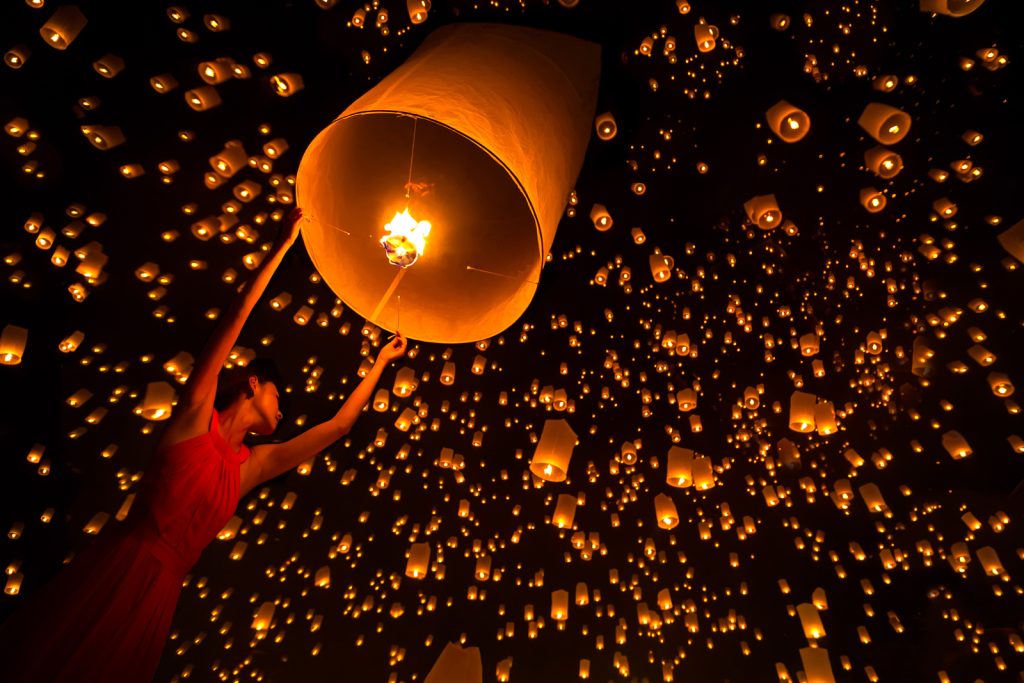
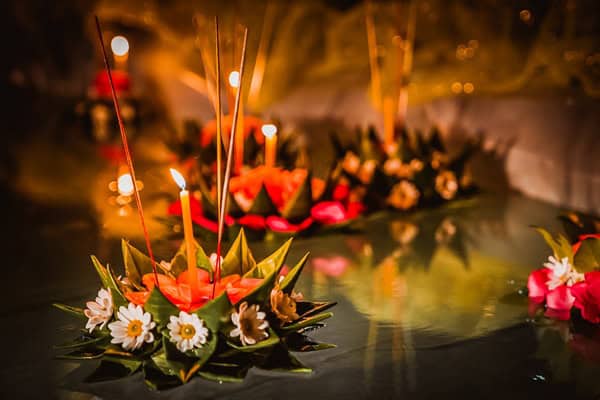
Food in Chiang Mai is deeply woven into its festivals and seasonal celebrations. During Songkran in April, the Thai New Year, the city comes alive with festive snacks, refreshing drinks, and sticky rice treats that fuel both temple visits and the famous water fights. In November, the twin lantern festivals of Yi Peng and Loy Krathong fill the streets with local sweets, grilled snacks, and night market delicacies enjoyed as lanterns rise into the sky and krathongs float along the rivers.
The cool season from November to February brings an abundance of fresh produce, with strawberries, mountain-grown herbs, and crisp vegetables marking the harvest. Throughout the year, temple fairs and seasonal markets showcase unique bites and homemade specialties, turning food into a way of celebrating Buddhist rituals, family gatherings, and the rhythms of the agricultural calendar.
Practical Tips for Foodies in Chiang Mai
- Best time: Morning for fresh bites, evening for street food buzz.
- Hygiene: Pick busy stalls, hot & freshly cooked food.
- Thai phrases: Aroi mak (delicious), Mai phet (not spicy).
- Costs: Snacks ฿20-40, meals ฿40-70, cafes ฿100+, upscale ฿400+.
- Transport: Tuk-tuks, red trucks (songthaews), scooters, Grab.
Beyond Khao Soi: Discover the Soul of Northern Thai Food
Chiang Mai truly stands as the culinary heart of Northern Thailand, where every bite tells a story of Lanna heritage, hill-tribe traditions, and cross-border influences. From the rich coconut broth of Khao Soi to the fiery kick of Sai Oua, the city’s food culture is as diverse as its people.
But the real magic lies beyond the famous dishes-hidden noodle shops, bustling morning markets, and indie cafes tucked away in Nimmanhaemin all offer unforgettable flavors waiting to be discovered.
So, come hungry and curious. If it’s a street food crawl, a hands-on cooking class, or a visit to lush coffee plantations, Chiang Mai promises a feast for the senses.
Book your Chiang Mai food tours, market walks, and cooking classes with Thrillark and taste the city like a local.
Extra Things to Do in Chiang Mai
Food may be the soul of Chiang Mai, but there’s so much more to explore. Between meals, you can discover the city’s majestic temples, wander through its night markets, plan a scenic day trip to Doi Inthanon National Park, or spend meaningful time at ethical elephant sanctuaries. And if you’re lucky to visit during festivals like Yi Peng or Songkran, you’ll find that Chiang Mai’s cultural spirit is just as rich as its cuisine.
Learn more about the Things to do in Chiang Mai and extend your trip, have a proper break, and make it extraordinary. If you’re confused about which month and weather will be apt for your Chiang Mai trip, also read Best Time to Visit Chiang Mai: Weather, Festivals & Seasonal Tips.
FAQs About Food in Chiang Mai
Q.1. What food is Chiang Mai famous for?
Chiang Mai is best known for its legendary Khao Soi, a creamy coconut curry noodle soup topped with crispy noodles. But beyond that, you’ll find delicious local favorites like Sai Oua (herby sausage), Gaeng Hung Lay (pork curry), and Nam Prik dips that locals love.
Q.2. Where’s the best place to try street food in Chiang Mai?
The magic happens at the night markets! Chiang Mai Gate Market and the Sunday Walking Street are foodie heavens. If you want a local favorite, head to Chang Phuak Gate Market to look for the famous “Cowboy Hat Lady” serving unforgettable Khao Soi.
Q.3. Is Chiang Mai food spicy?
Northern Thai food leans more on herbs and aromatics than extreme spice. Dishes like Laab Kua and Nam Prik Noom can have a kick, but you can always ask vendors to make it mai phet (not spicy) if you prefer mild flavors.
Q.4. Can vegetarians and vegans enjoy Chiang Mai food?
Absolutely! Many restaurants offer vegan Khao Soi, tofu curries, and mushroom-based dishes. The city also has a thriving café culture with vegan-friendly spots and smoothie bars, especially around Nimmanhaemin and Old Town.
Q.5. How much does street food cost in Chiang Mai?
That’s the best part: it’s budget-friendly! A bowl of noodles or curry usually costs 30–60 THB ($1–2 USD), while snacks like spring rolls or roti are even cheaper. Eating your way through Chiang Mai won’t break the bank.
Q.6. Is it safe to eat street food in Chiang Mai?
Yes, as long as you pick stalls that look busy and clean. If locals are lining up, that’s a good sign. Go for freshly cooked dishes, avoid food sitting out too long, and you’ll be just fine.
Q.7. What’s the best foodie experience in Chiang Mai?
If you want more than just eating, try a cooking class to learn how to make Khao Soi yourself, or join a street food tour with a local guide who’ll take you to hidden gems.
Q.8. What food should I try during Songkran in Chiang Mai?
Songkran (Thai New Year, every April) is all about fun, water fights, and festive snacks. You’ll find refreshing treats like iced desserts, fruit juices, and sticky rice snacks sold along the streets to cool you down in the heat.
Q.9. Are there special foods during the Yi Peng & Loy Krathong festivals?
Yes! During these magical lantern festivals in November, you’ll see stalls selling traditional sweets, grilled snacks, and seasonal treats around the river and temples. Eating street food while releasing lanterns into the sky is a must-do Chiang Mai experience.
Q.10. What seasonal foods can I try in Chiang Mai?
If you visit between November and February, you’ll catch the cool-season harvest. That means fresh strawberries, mountain herbs, and organic produce from the hills, often sold at local markets and farm-to-table cafes.
Q.11. Do temple fairs in Chiang Mai have food too?
Absolutely! Temple fairs are not just about merit-making; they’re also foodie heavens. You’ll find stalls with grilled meats, curries, sweets, and local snacks, often prepared by families as part of the celebration.


